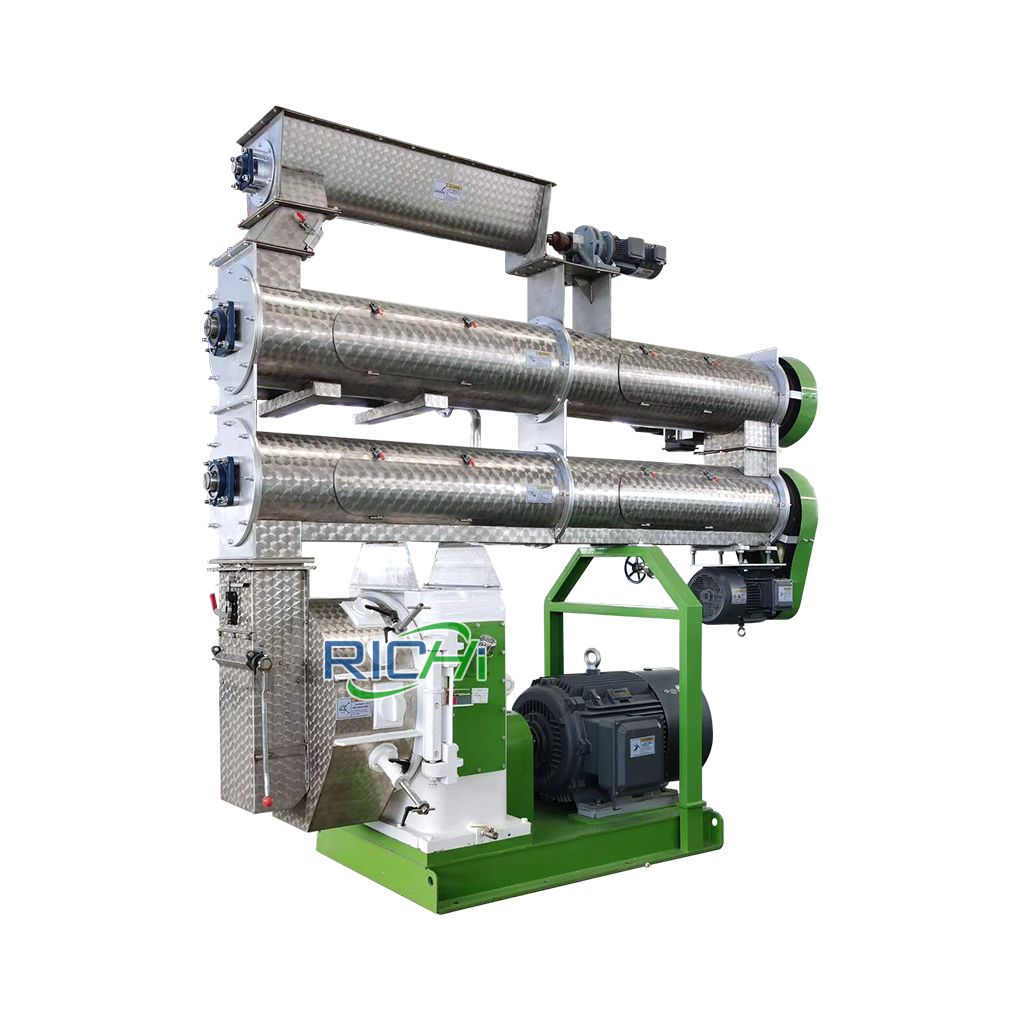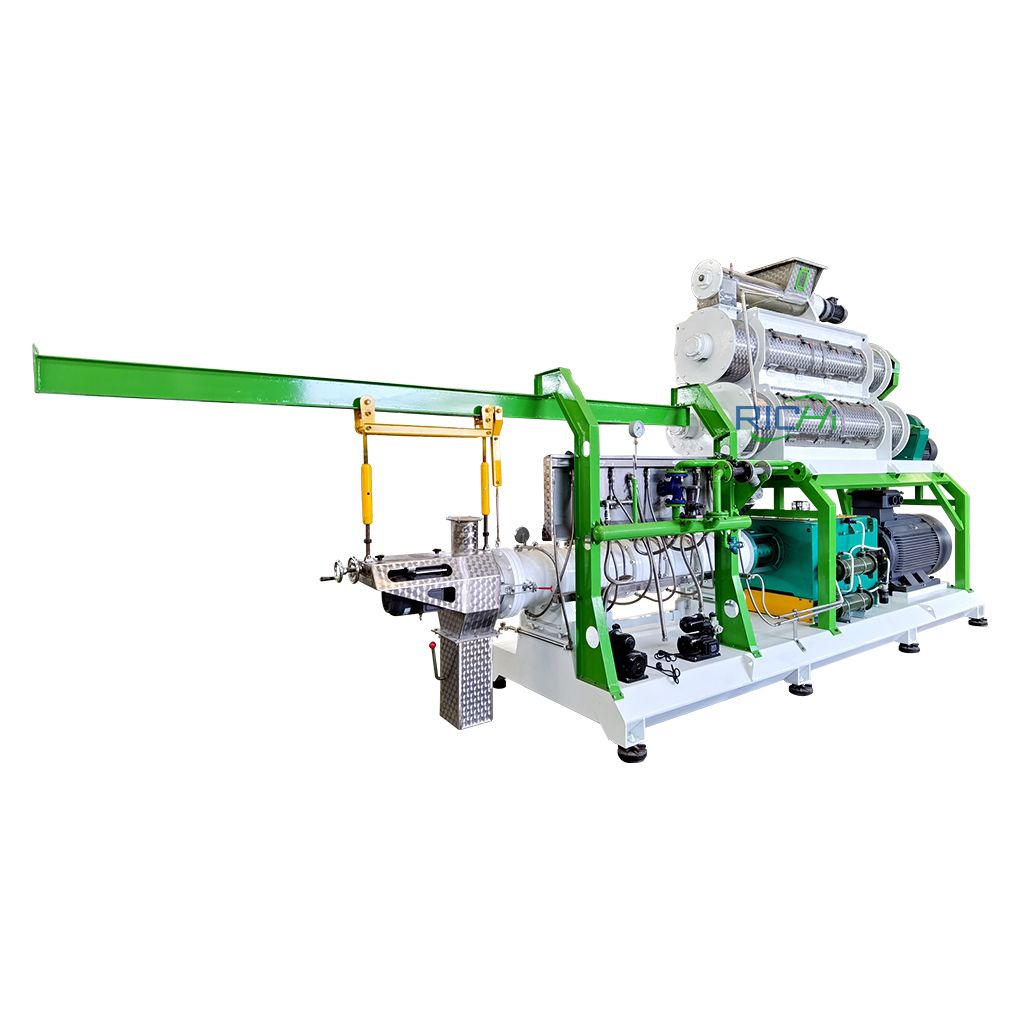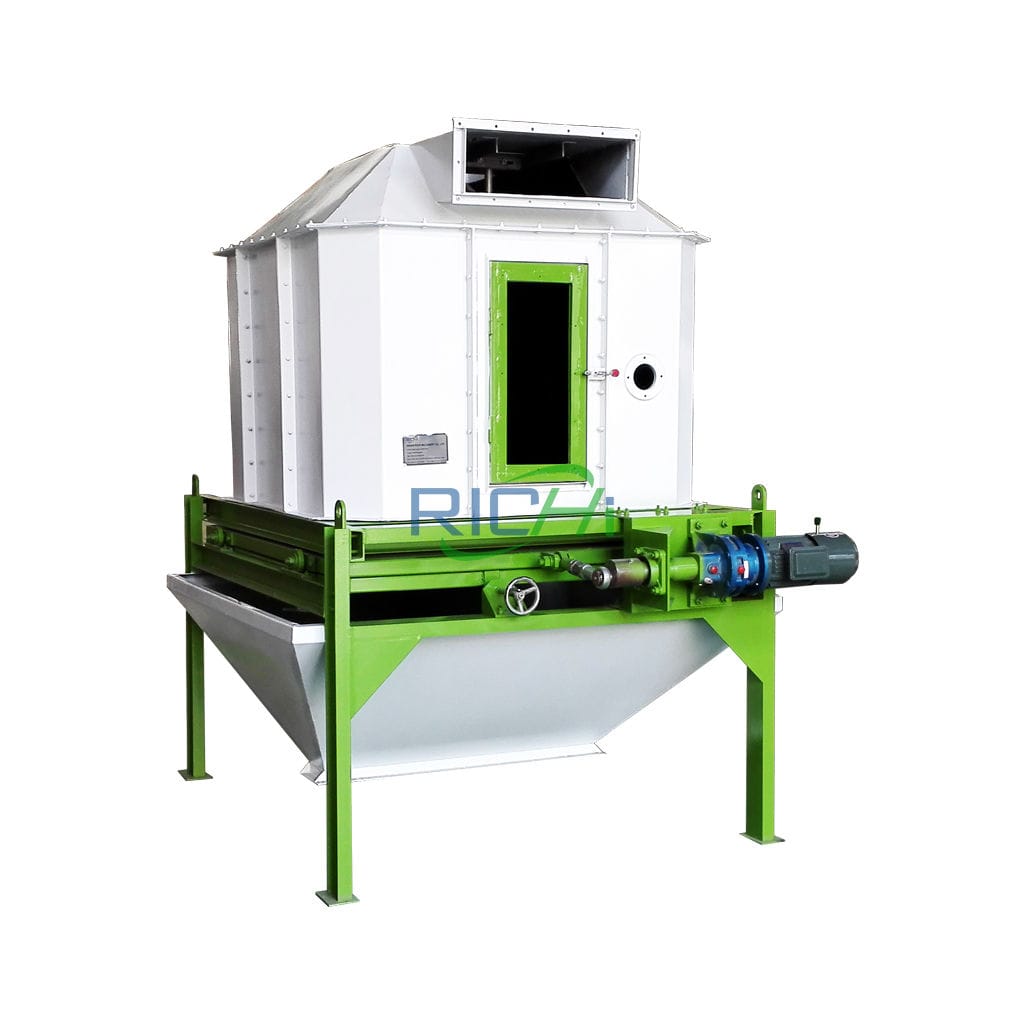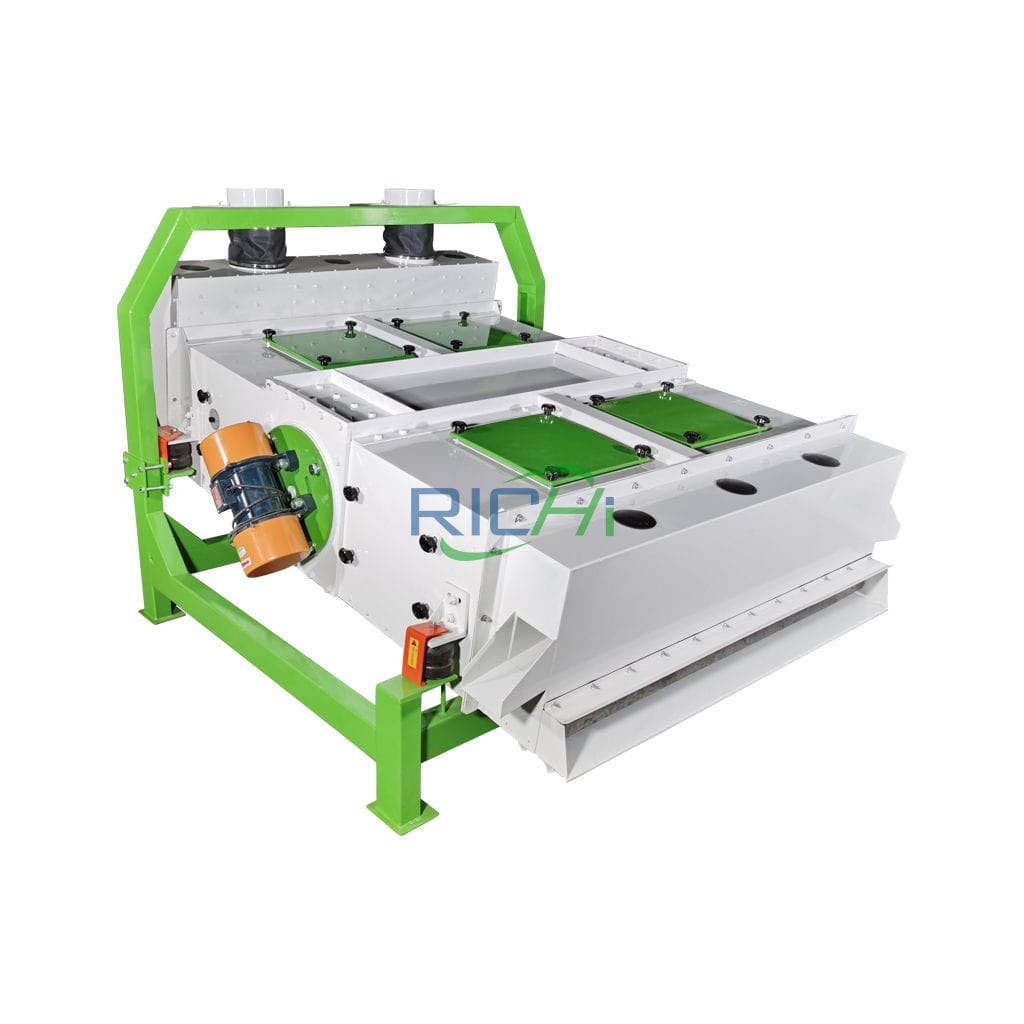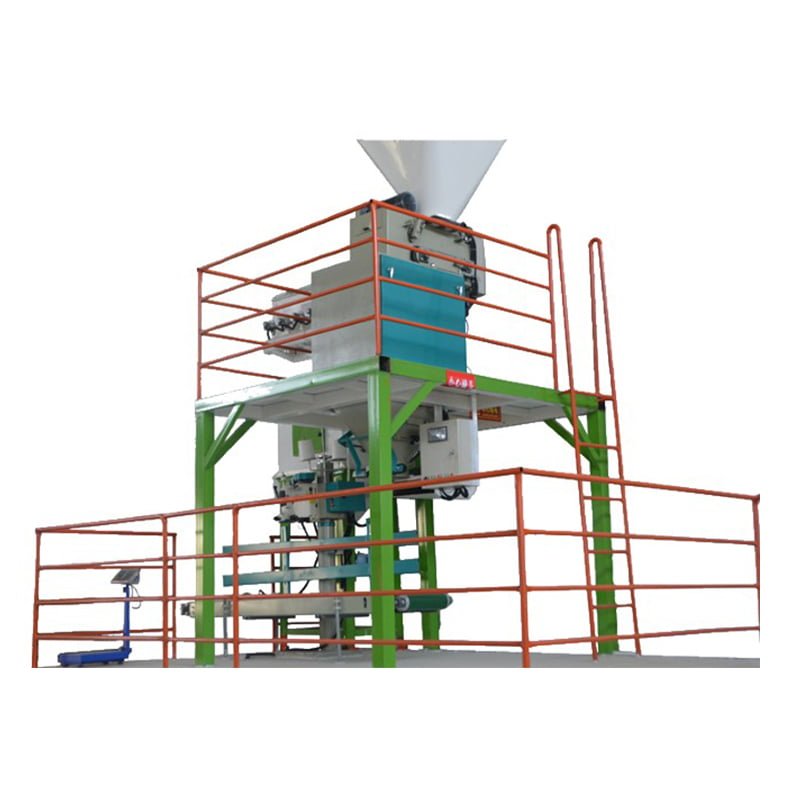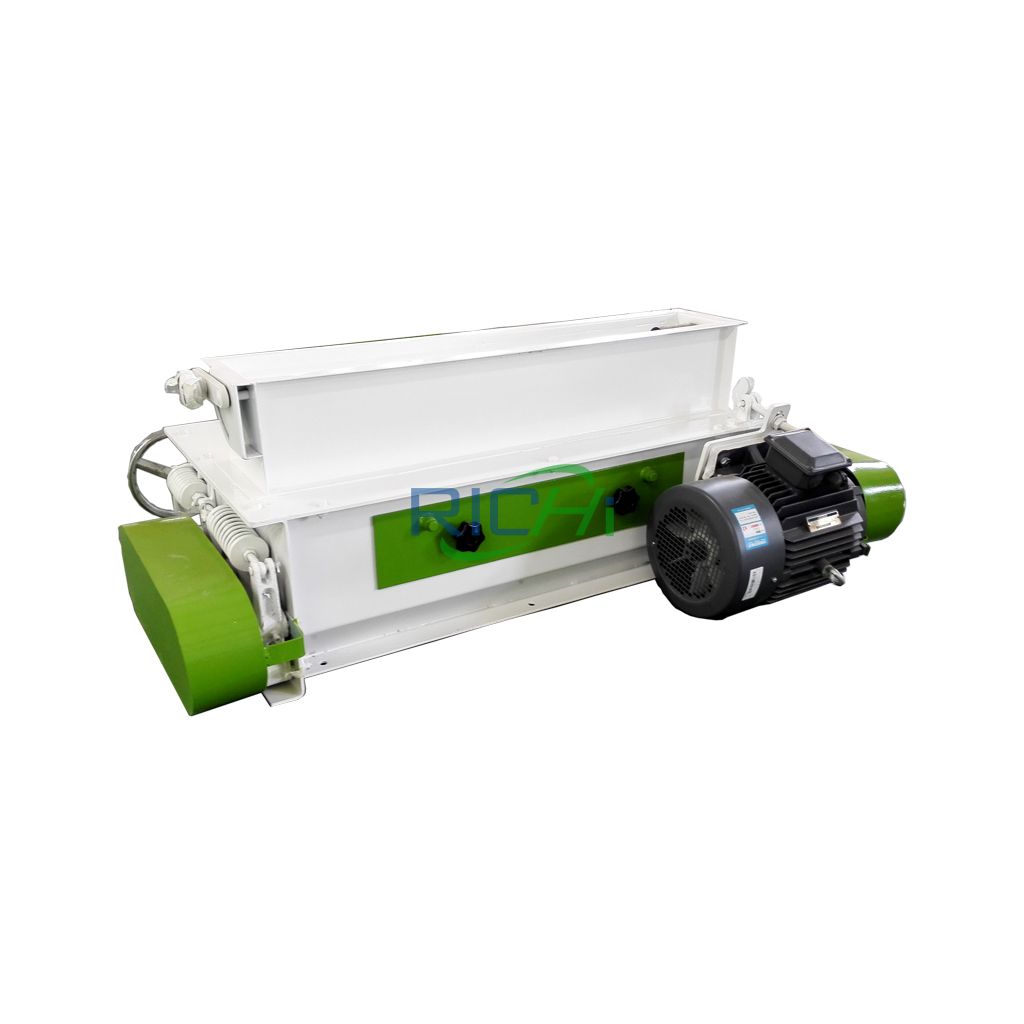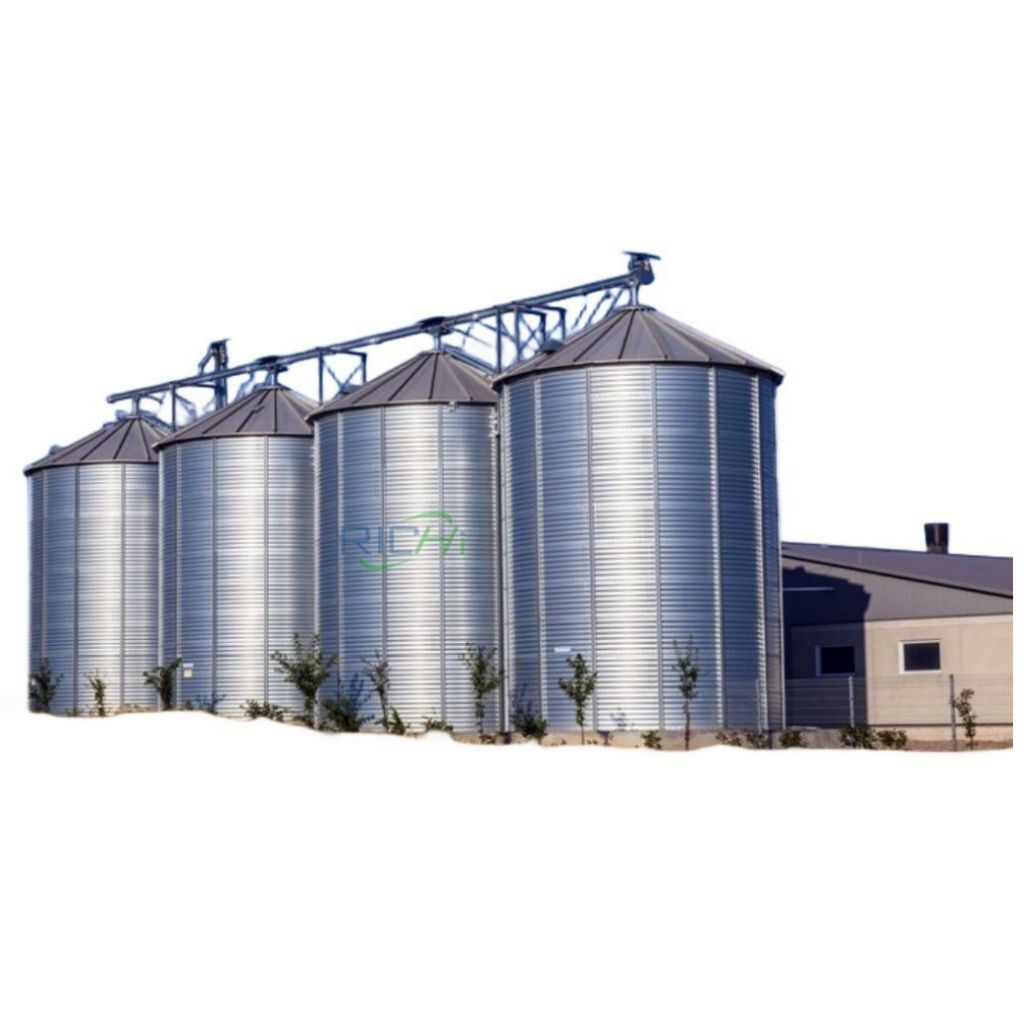
Compound Feed Mill
Compound feed mills are the most widely used feed processing systems. A compound feed plant can be used to produce one or more compound feeds types.

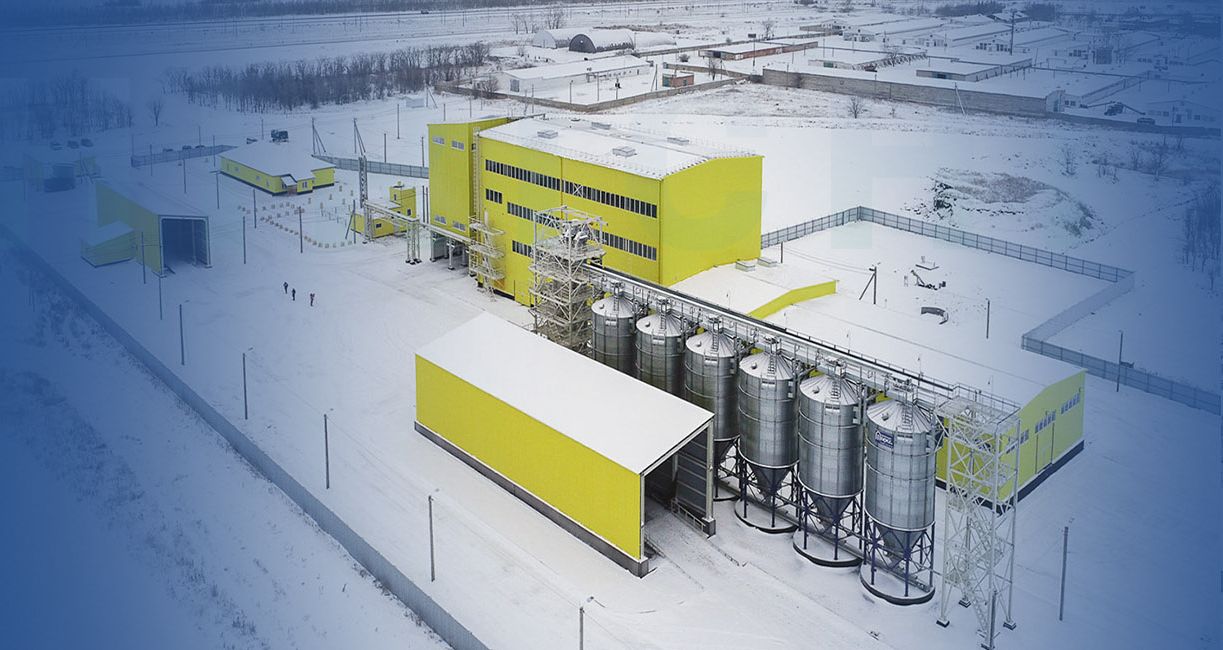
From weighing to proportioning, mixing, conditioning, pelleting, expanding and extruding, cooling, screening and bagging – Richi Machinery not only supplies you with all the machines for an industrial compound feed mill, but also takes over the planning, logistics and necessary construction measures for a turnkey handover.
- Capacity: 1-160 T/H
- price: 10,000-5,000,000 USD
- Feed Type: Pellet feed, powdered feed, crushed feed, extruded feed
- Scope of application: pigs, chickens, ducks, geese, quails, rabbits, cows, etc.
- Business scope: New compound feed factory, compound feed factory renovation
RICHI specializes in the production of compound feed plants and complete sets of compound feed machinery and complete compound feed processing projects.
It can provide customers with livestock compound feed (pig, etc.), poultry compound feed (chicken, duck, goose, etc.), ruminant compound feed (cattle, sheep, etc.), general aquatic products Compound feed (four major fish species, etc.), special aquatic compound feed (shrimp, crab, etc.), expanded aquatic compound feed (floating and sinking fish feed, shrimp, etc.), pet compound feed (cat food, dog food, etc.) complete equipment solutions to meet the different needs of customers.
Compound feed definition
What is compound feed? Compound feed is formulated according to the requirements of feeding standards and is formulated into various specifications for various livestock and poultry, aqua, pet at different growth and development stages.
It can fully meet the needs of livestock and poultry for various nutrients in different growth periods. It has good feeding effects and is popular among the majority of livestock breeders. Welcome to the household.
- Classified by nutritional components and uses: complete compound feed, concentrate feed, concentrate mixture, additive premix feed, super concentrate, mixed feed, artificial milk or milk replacer
- Classified by feed shape: pellets, powder, crushed feed, extruded feed, flat feed, liquid feed, floating feed, block feed
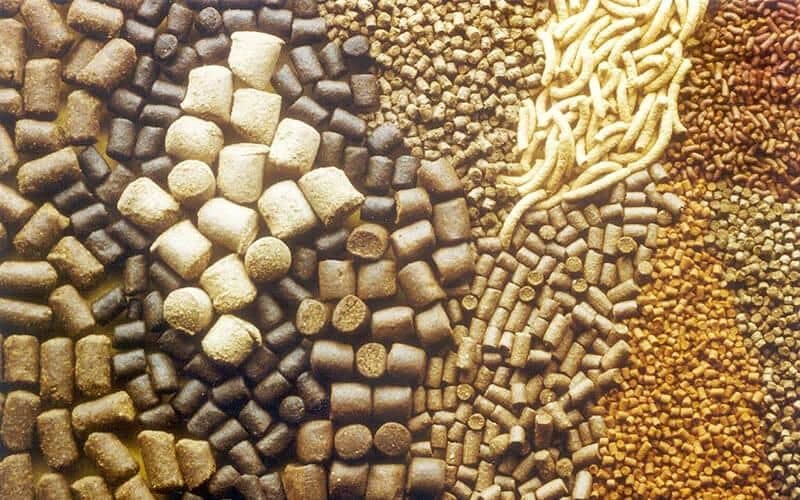
Since pellet feed processing is the most widely used, the following classification and process description of compound feed mill plants are based on pellet feed processing.
compound feed mill types
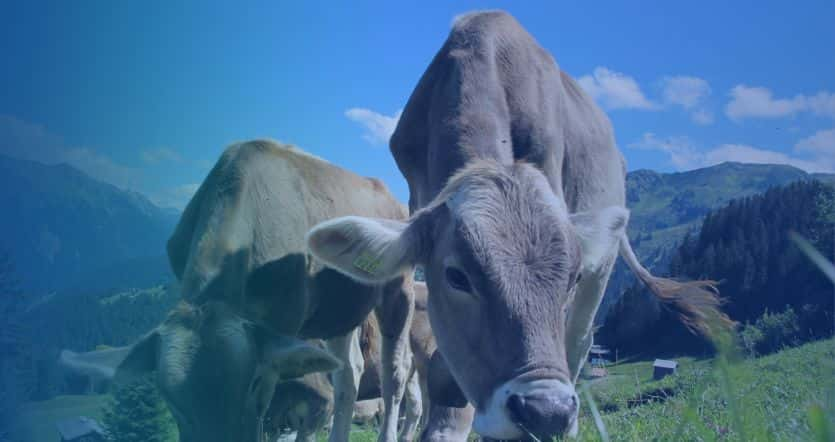
fully automatic cattle feed plant
It is used to process beef cattle feed and dairy cattle feed, including grass-based compound feed and grass-free compound feed for cattle.

poultry feed plant
Used for processing various poultry pellet feeds and powdered feeds such as chickens, ducks, geese, birds, quails, turkeys, etc.
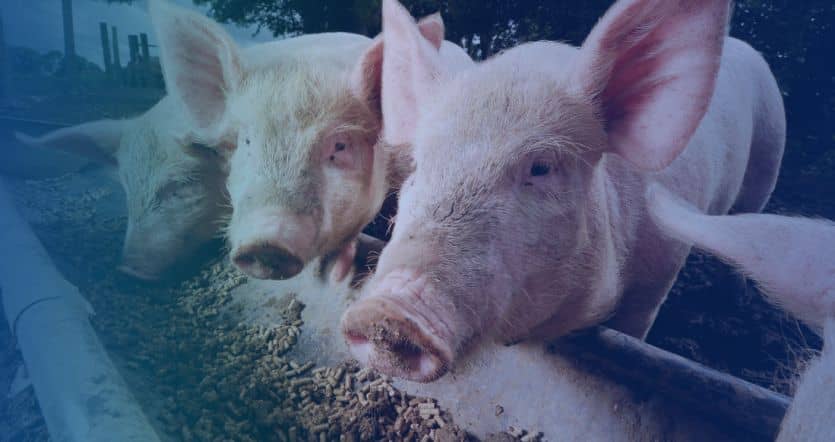
pig feed mill
It is used to process pig feed in various growth stages and can be equipped with raw material puffing technology.

chicken feed mill plant
Used for processing pellet feed, mash feed, powdered feed, crumbles feed for laying hens, broilers, etc.

horse feed mill
Horse feed mill is used for the processing of livestock and horse feed pellets, generally containing grass.

pet feed mill
Pet feed mill plant is used to process all kinds of pet pellet compound feeds for dogs, cats, birds, rabbits, etc.

Sinking Fish Feed Production Plant
Used for processing sinking type pellet fish feed with pelletizing technology.(Use fish feed pellet making machine)
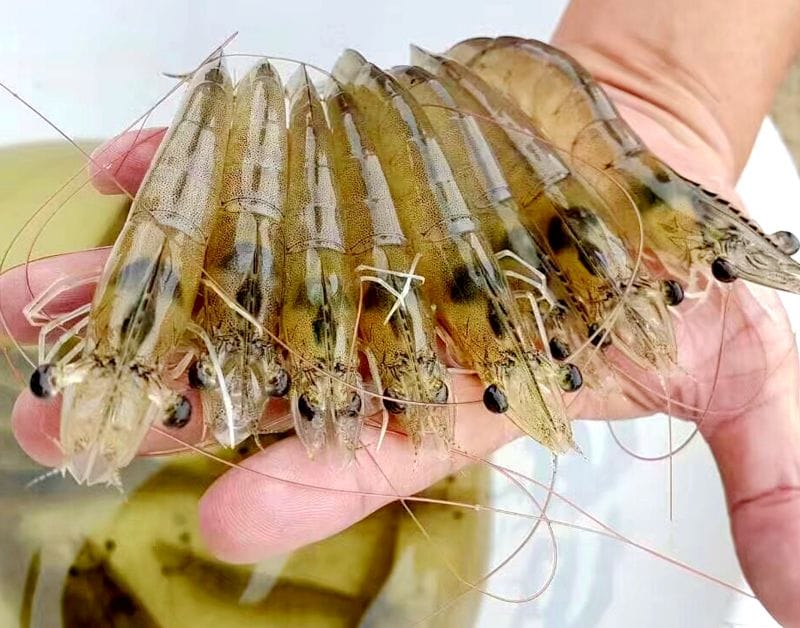
shrimp feed mill
Used for processing pellet shrimp feed and expanded shrimp feed. (Can use shrimp feed pellet machine or shrimp feed extruder)

Floating fish feed mill
Used for processing puffed fish feed pellets using extrusion technology. (Use floating fish feed extruder machine)
RICHI is the leading manufacturer for compound feed mil and compound feed making machines. The range offered by us consists of Livestock Feed Mill, Poultry Feed Mill, Aqua Feed Mill, Pet Feed Mill etc.
These products are having a high preference in the market because of their application specific design, simple usage, low maintenance cost, easy installation and long working life. Manufacturing of the offered range is done as per the norms of the industry. We are providing offered product range at budget friendly price. In addition, these offered machines are used in the agriculture field.
compound feed mill process design
RICHI is continuously upgrading the compound feed mill technology as per the demands coming from markets and current trends. Factory process design is a relatively complex task. A good compound animal feed mill plant process design not only guarantees product quality, but also reduces input and use costs. At the same time, process design also needs to be quite flexible and adaptable to meet the needs of producing various products.
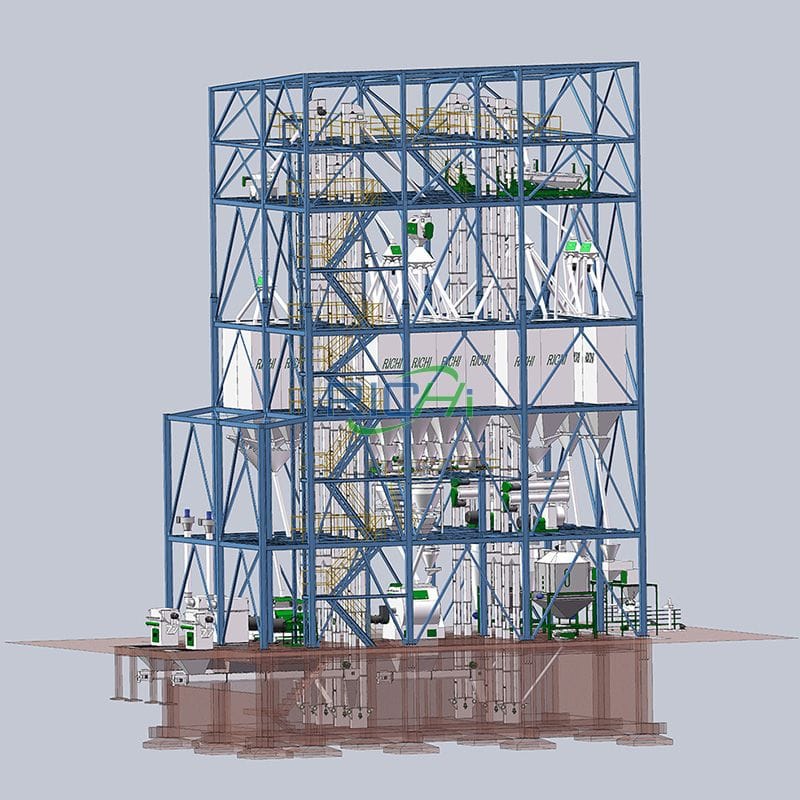
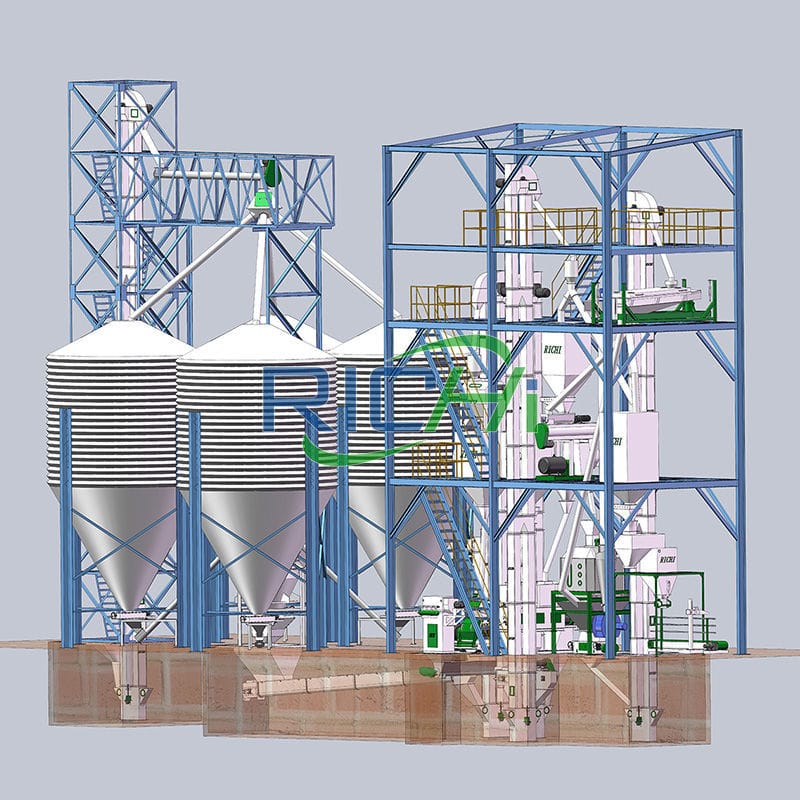
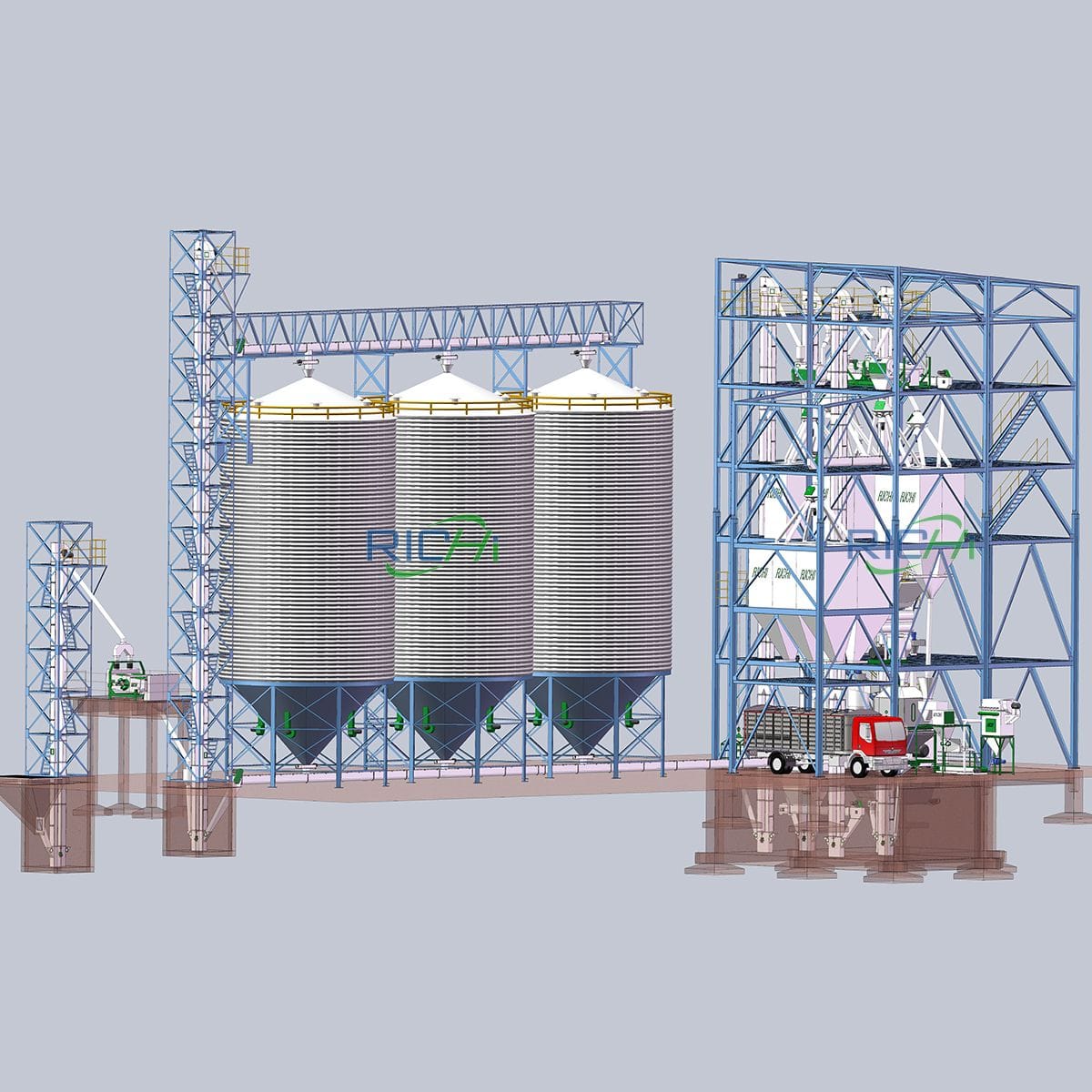
Since the feed technology of complete compound feed is the most widely used, the following takes the processing technology of complete compound feed as an example. The process flow of compound feed mill includes the following sections:
01 Raw material cleaning
The first step in feed processing is to clean the raw materials. The raw materials are often mixed with impurities, stones, soil, etc., which need to be cleaned through screens, magnets and other equipment to ensure the purity and safety of the raw materials.
02 Raw material crushing
Generally speaking, feed raw materials have different particle sizes and need to be evenly and finely crushed through a crushing process. Common crushing equipment includes jaw crushers, hammer crushers, etc., which crush raw materials through mechanical force to make them suitable for subsequent mixing and processing.
03 Mixing of raw materials
An important link in feed processing is the mixing of raw materials. By mixing raw materials of different ingredients together in a certain proportion, the content of various nutrients in the feed can be balanced, making the feed more balanced and comprehensive. Common mixing equipment includes mixers, mixers, etc., which fully mix the raw materials through rotating stirring.
04 Conditioning of raw materials
Conditioning of raw materials means making appropriate adjustments to the feed according to the needs of different animals. By adding appropriate amounts of vitamins, minerals, amino acids and other nutrients, the nutritional value of feed can be improved to meet the needs of different animals.
05 Raw material granulation
Pelleting is an important process in feed processing. By feeding the mixed raw materials into the animal feed pellet making machine, mechanical force and heat are used to form them into granules, thereby improving the edibility and stability of the feed. The pelleted feed is not easy to scatter and is easy to store and use.
06 Pellet cooling
During feed processing, raw materials often contain a certain proportion of moisture. Excessive moisture will cause the feed to deteriorate and become moldy, affecting the quality and nutritional value of the feed. Therefore, a pellet cooling process is required to control the moisture content of the feed within an appropriate range.
07 Screening section
The cooled feed pellets are screened, qualified pellets enter the packaging section, and unqualified particles or unformed powder will be re-granulated.
08 Raw material packaging
After the compound feed pellet processing is completed, the packaging process needs to be carried out. Maintain the freshness and quality of feed by sealing and packaging it using suitable packaging materials and equipment. Common packaging materials include plastic bags, woven bags, etc.
09 Storage of finished products
After the feed processing is completed, the storage process of the finished product needs to be carried out. By storing packaged feed in a dry, ventilated, and cool place, you can extend the shelf life of the feed and ensure that the quality of the feed is not compromised.
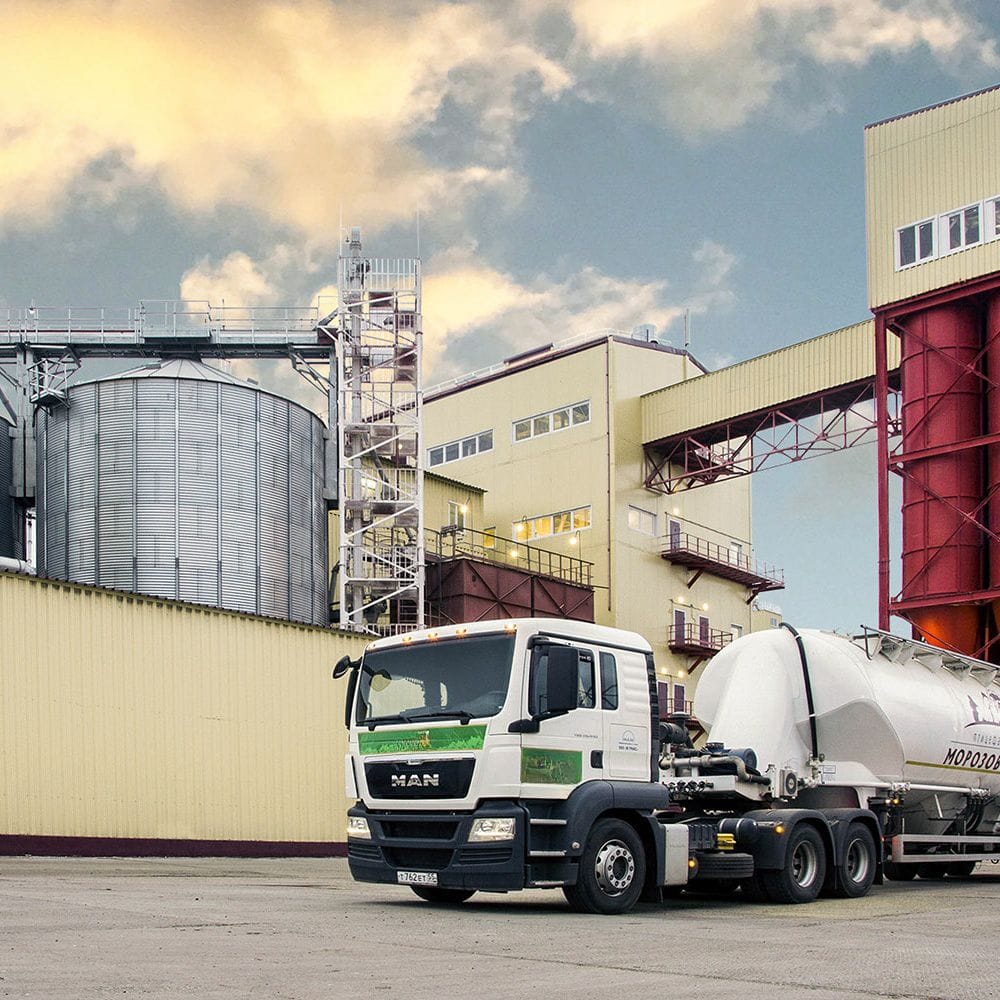
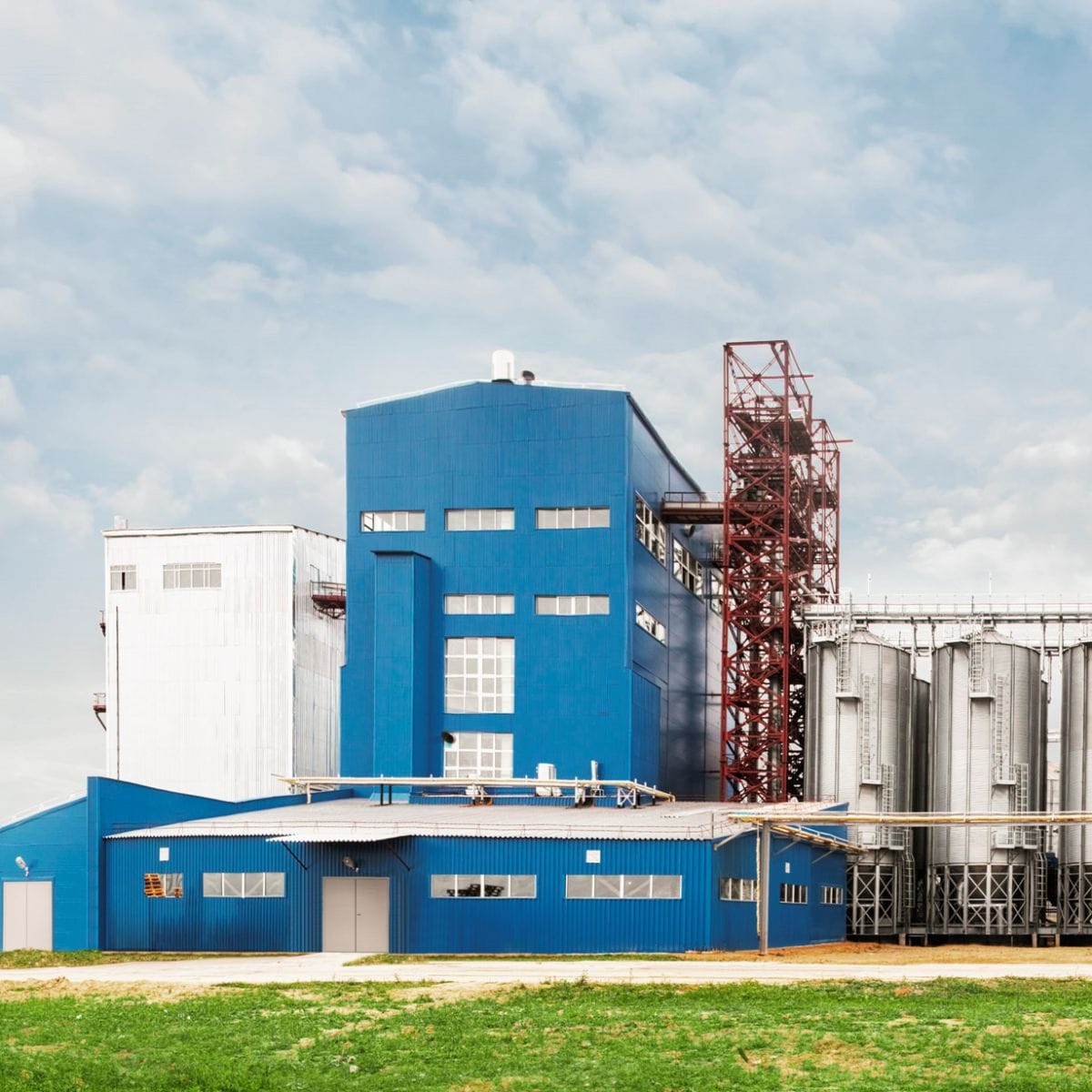
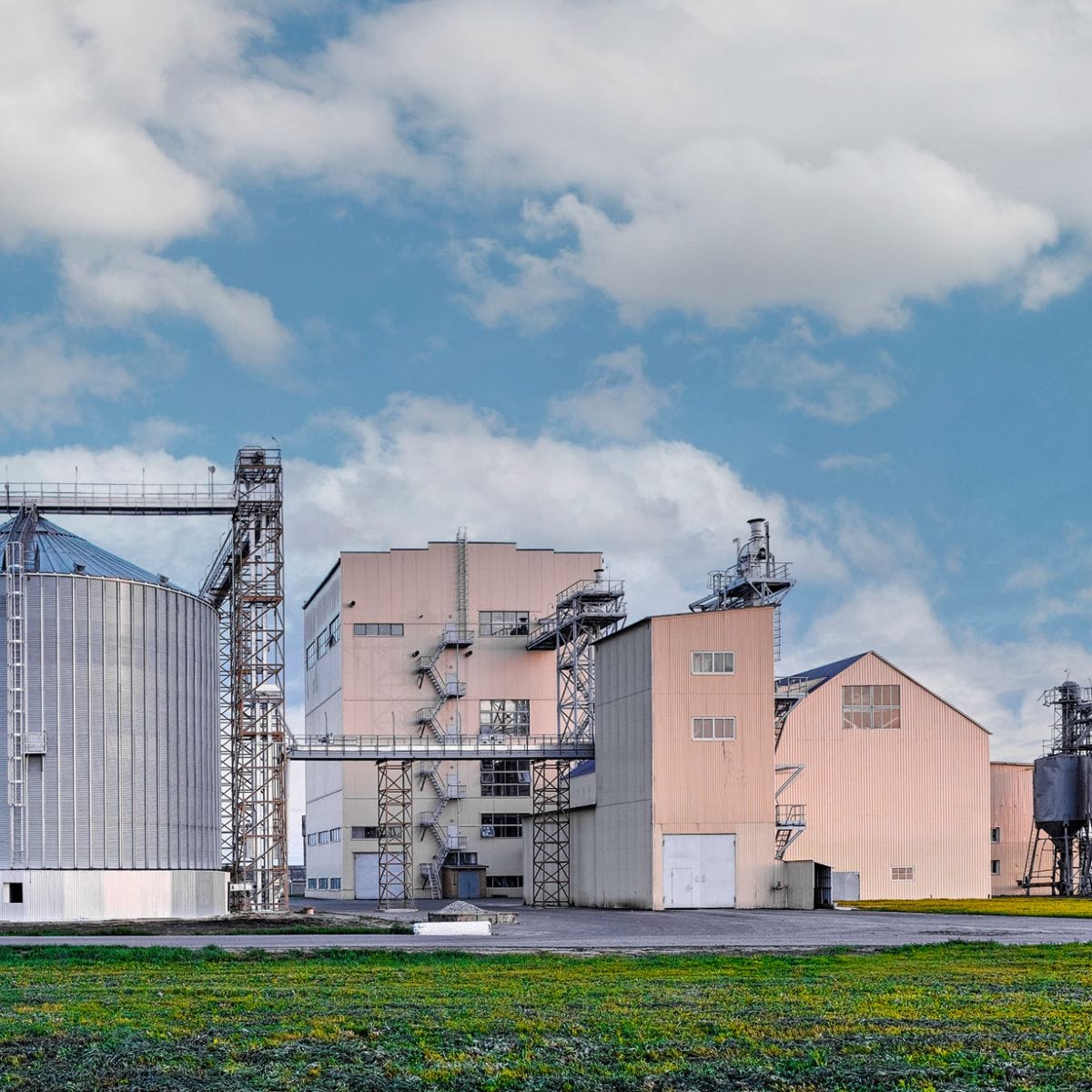
The processing of compound feed plays an important role in improving the quality and nutritional value of the feed. Through the cooperation of raw material cleaning, crushing, mixing, conditioning, granulation, drying, packaging and storage, high-quality feed suitable for different animal needs can be produced. The scientific standardization and meticulous operation of feed processing procedures will provide a solid guarantee for the growth, development and health of livestock and poultry.
Compound feed mill process design needs to consider the following points:
- Use the product line description and raw material description in the early preparation stage to select process specifications and determine the process.
- Use the description of the product production process to calculate process parameters and select compound feed mill equipment.
- Determine the power, dust removal, odor removal and noise reduction solutions required for the process by determining a good compound feed production process.
- Establish process operation procedures and determine program control methods with reference to ergonomics.
- Design and determination of enterprise information network.
The quality of compound animal feed is not only related to the formulation, but also related to the processing technology, equipment and quality control during the feed production.
Therefore, to ensure the compound feed quality, and increase the comprehensive economic benefits of breeding, we must select advanced feed processing technology and suitable compound feed mill machine, and conduct overall management and evaluation of feed quality.
Equipment for setting up compound feed mill
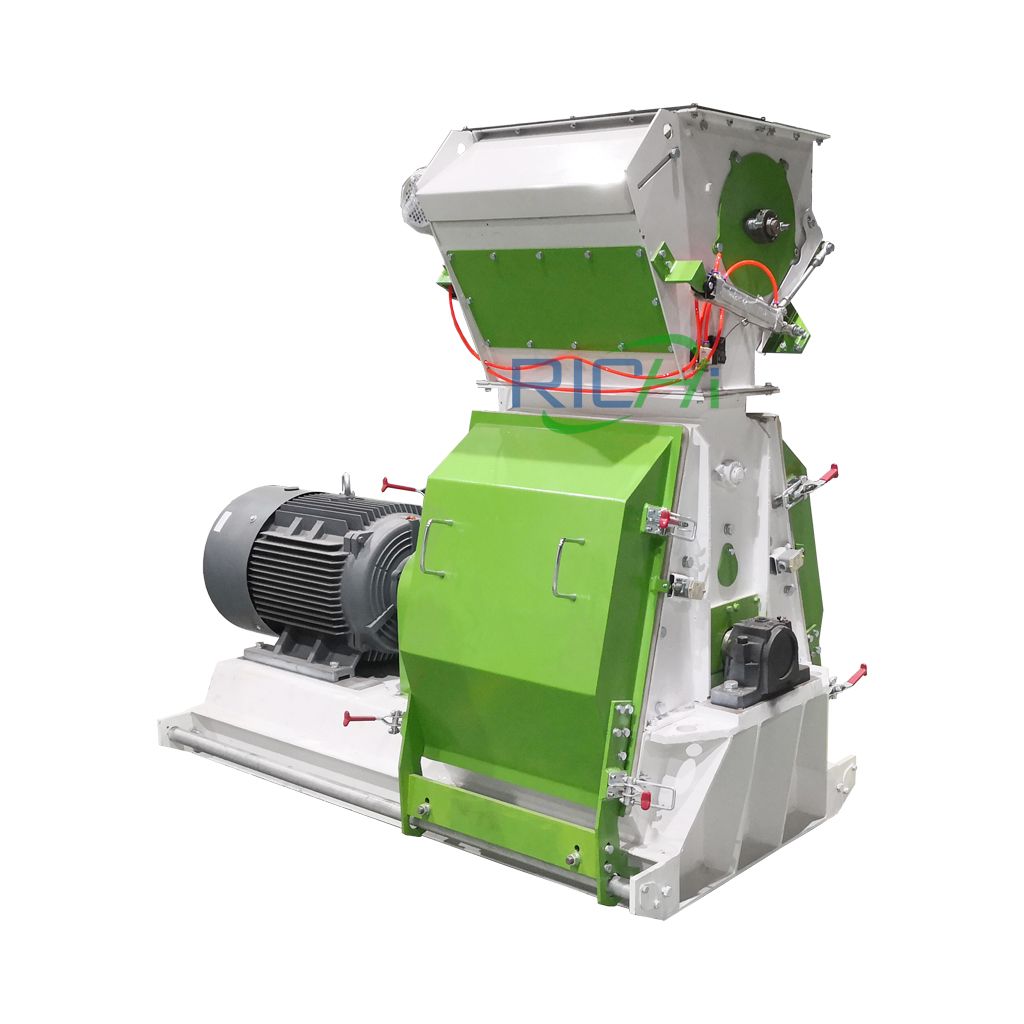
compound Feed hammer mill
Capacity:
3-25 T/H
Main Power:
30-160 KW
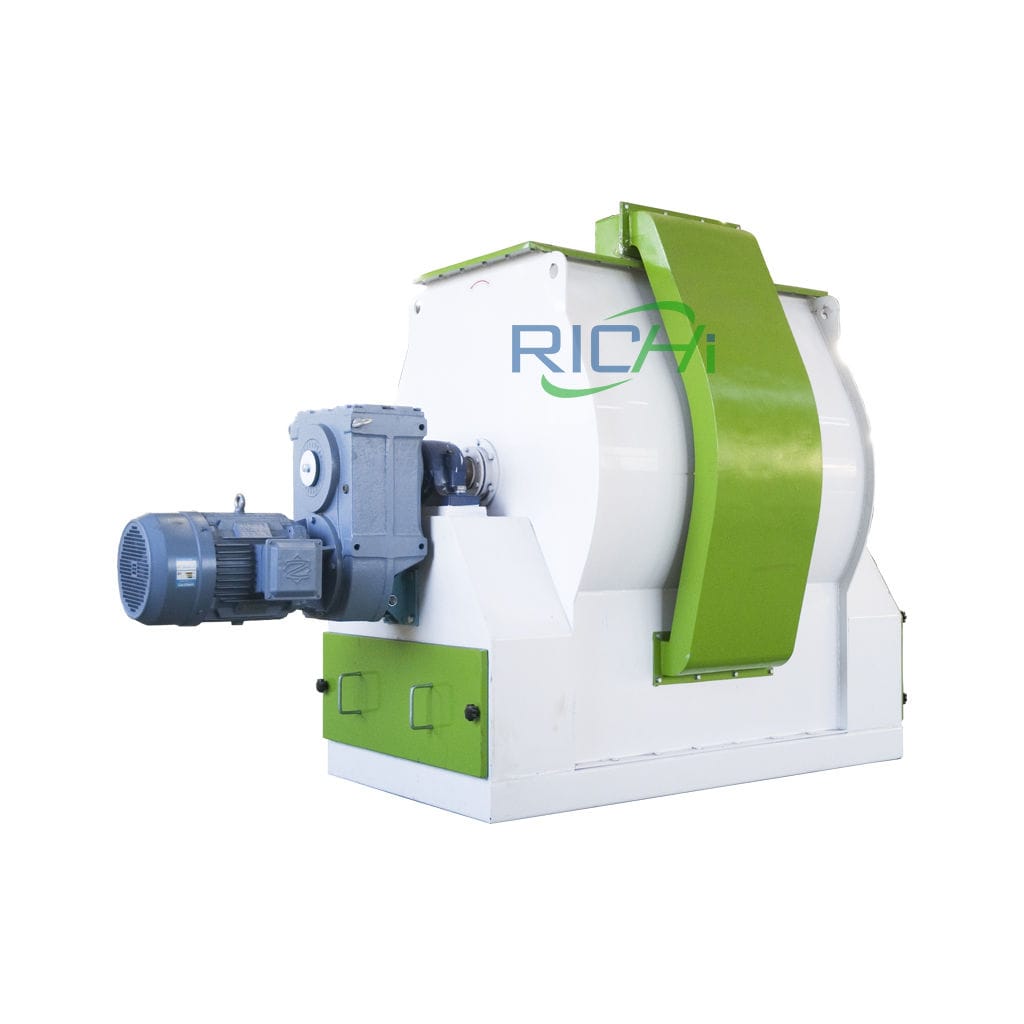
compound Feed Mixer machine
Capacity:
250-2000 KG
Main Power:
4-55 KW
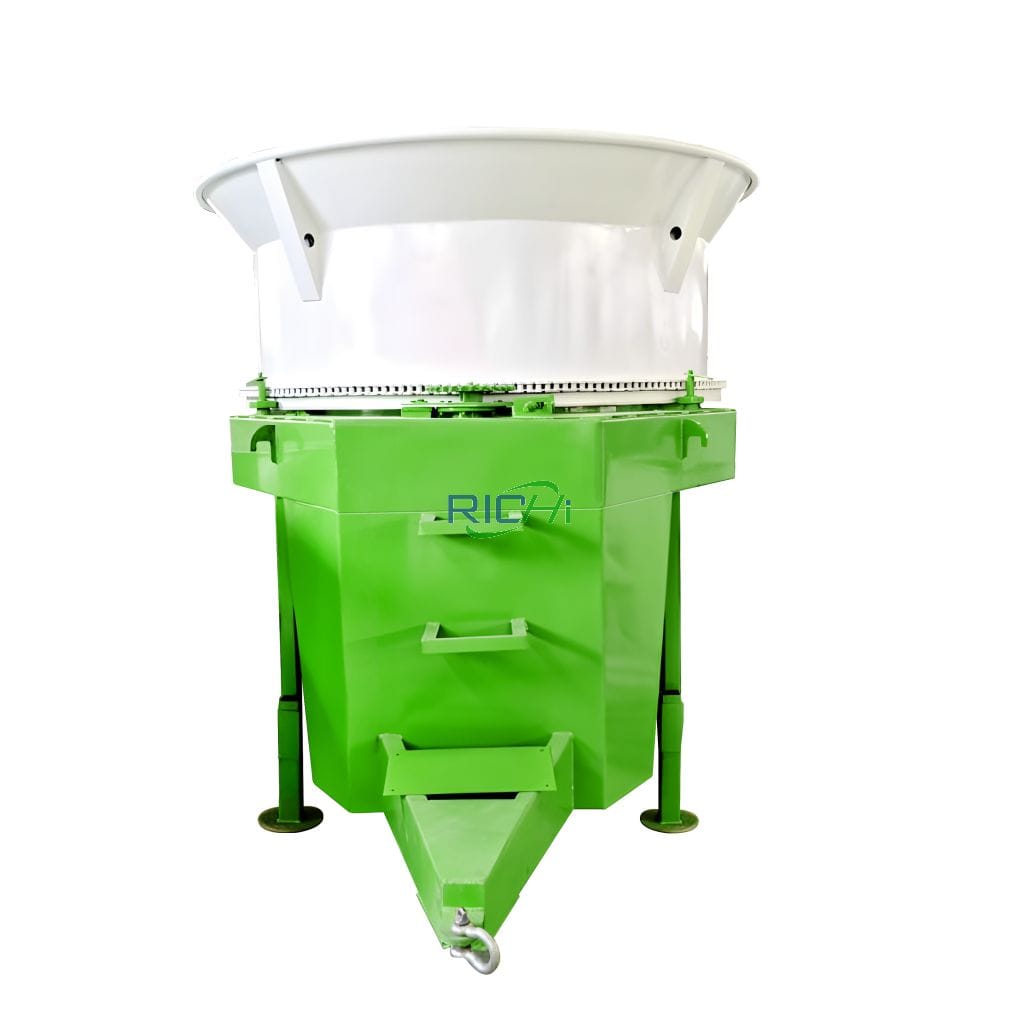
Bale breaker
Capacity:
1-20 T/H
Main Power:
30-90 KW
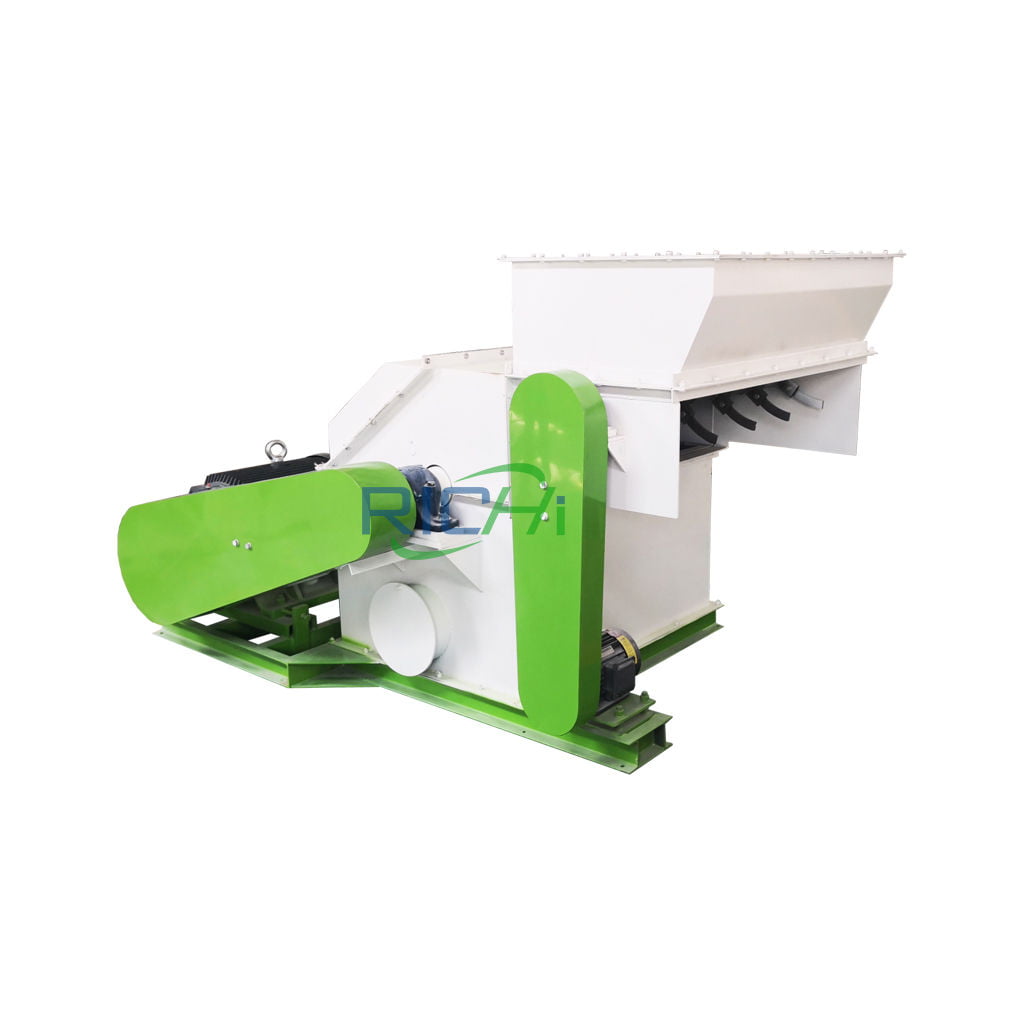
Grass hay alfalfa crusher
Capacity:
0.3-3 T/H
Main Power:
22-93 KW
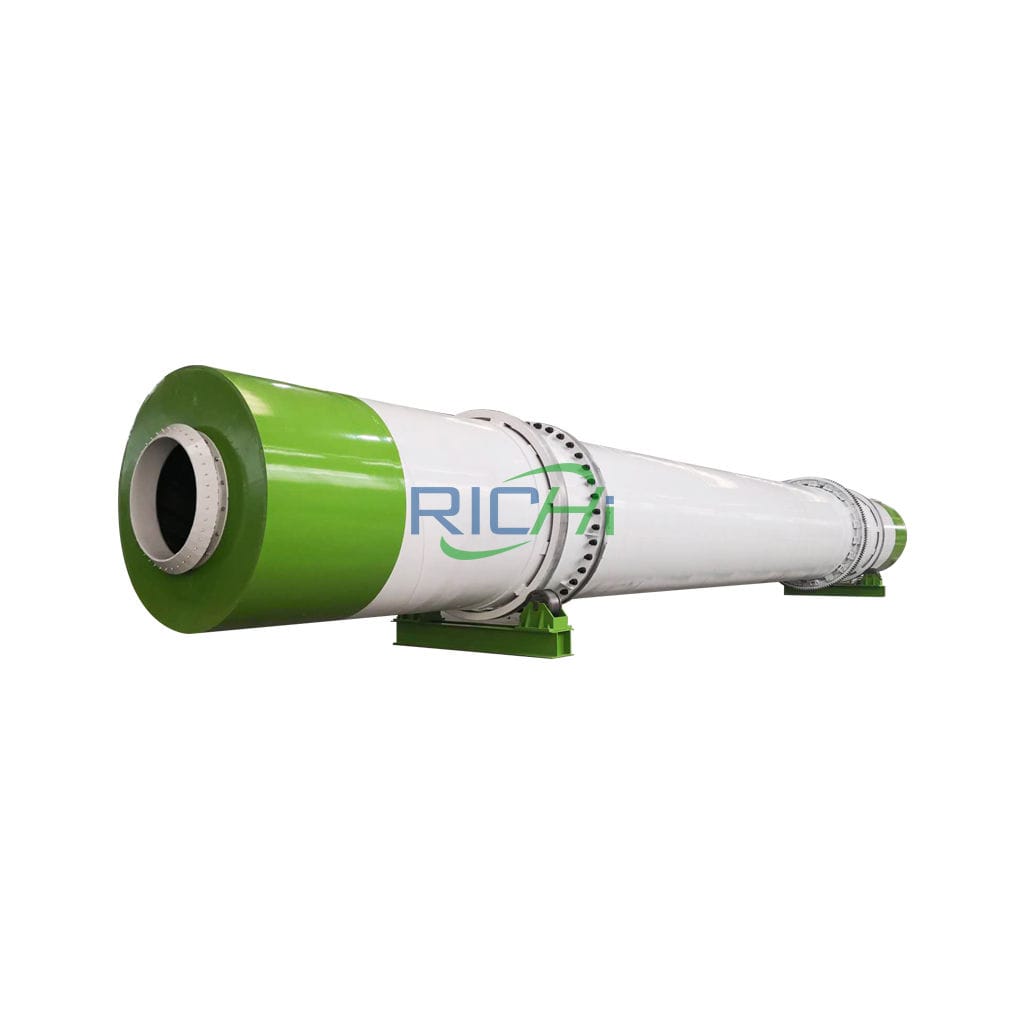
dryer machine
Capacity:
Customizable
Rotate speed
3-8 R/Min
By effective utilization of our state-of-the-art machinery and latest compound feed plant technology, we, RICHI Machinery, are able to fabricate a well engineered range of products.
We commenced our business operation with a sole vision to acquire an indelible status in the domestic as well as international market. With our persistent efforts and commitment, we have established a strong foothold in the field of manufacturing compound feed mill.
compound feed mill projects
RICHI is the leading manufacturer for compound feed making machines and compound feed plant. The company is in this business since last 25 years and successfully installed many plants in the world.
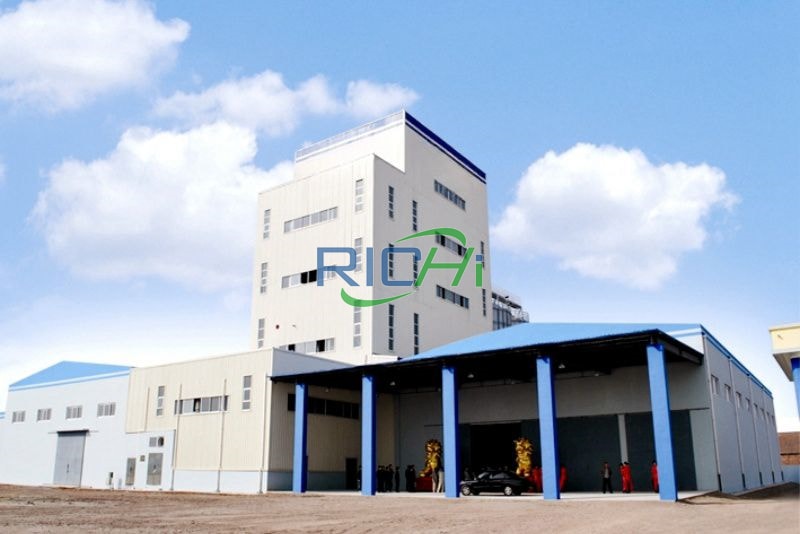
6-10T/H compound feed mill in Algeria project
- Date: Sep 21th, 2015
- Feed type: hen and cattle feed pellets
- project cost: 80,000-400,000 USD
- compound feed plant equipment: Feed crusher, mixer, granulator, cooler, hen feed making machine, baling scale, screening machine, silo system, etc.
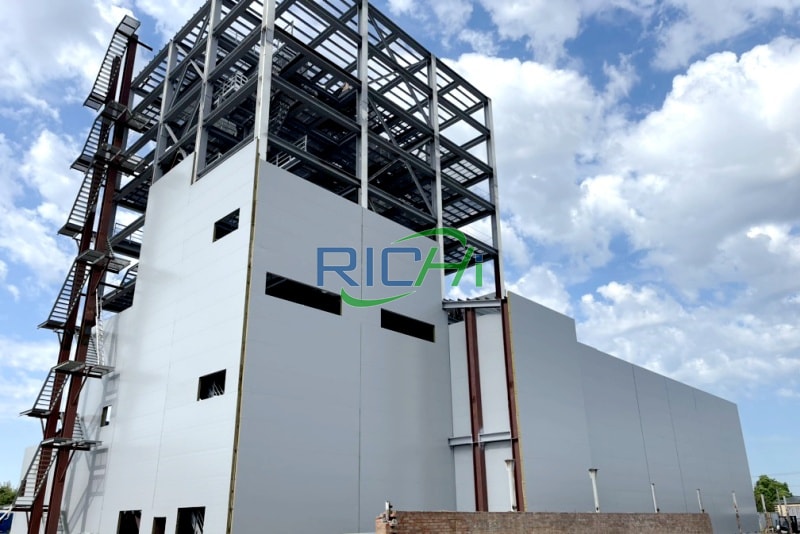
10-15T/H compound feed mill in Uzbekistan project
- Date: July 6th, 2019
- Feed type: broiler and cattle feed pellets
- project cost: 150,000-400,000 USD
- compound feed plant equipment: Feed grinder, mixer, broiler feed maing machine, cattle pelletizer, cooler, baling scale, pellet screener, silo system, boiler, etc.
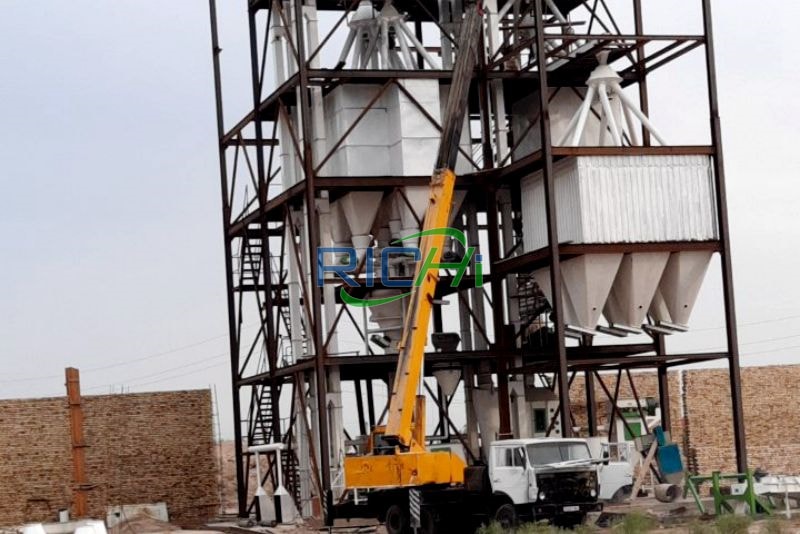
5T/H compound feed mill In Peru project
- Date: February 2021
- Feed type: poultry and cattle goat feed
- project cost: 220,000-250,000 USD
- compound feed plant equipment: Feed grinder, pulser, distributor, mixer, cattle feed pellet machine, cooler, poultry feed pellet making machine, baling scale, screening machine, boiler, etc.
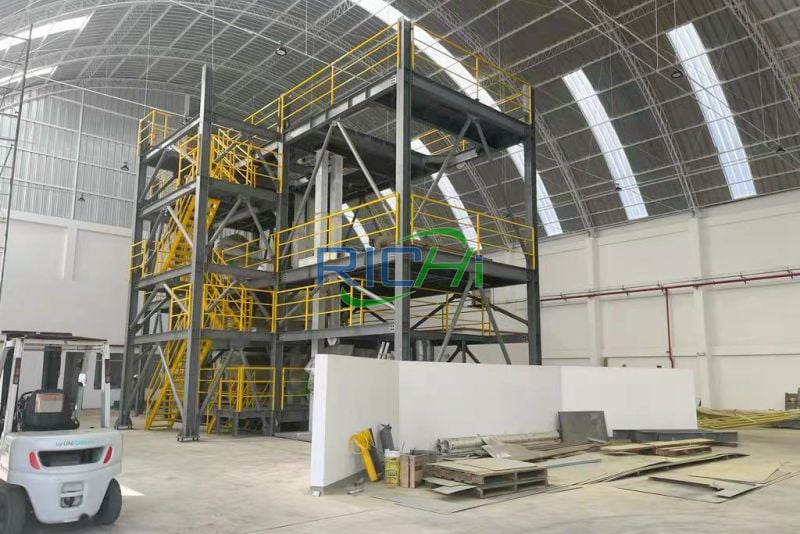
3-5T/H compound feed mill In Malaysia project
- Date: October 29, 2021
- Feed type: chicken and ruminant feed
- project cost: 60,000-65,000 USD
- compound feed plant equipment: animal Feed grinder, mixer, alfalfa pellet machine, cooler, pellet crumbler, baling scale, screening machine, etc.
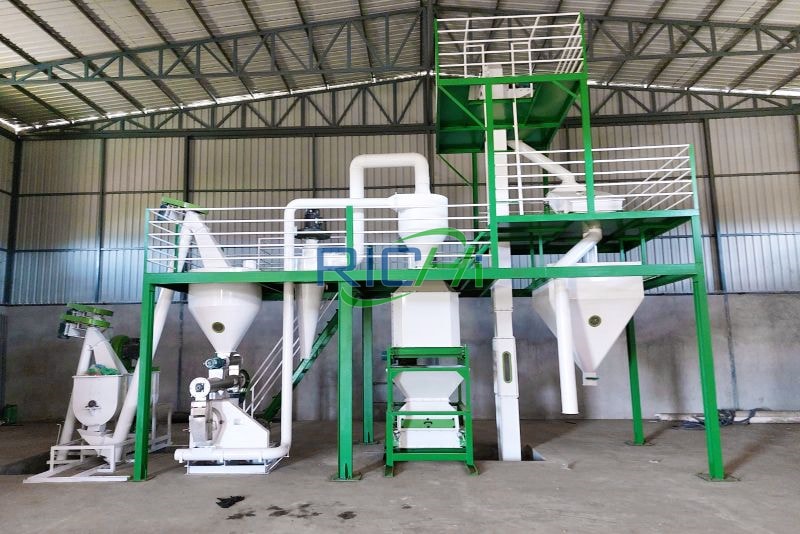
1-2T/H compound feed mill in Nigeria project
- Date: June 30, 2020
- Feed type: pig & cattle feed
- project cost: 25,000-29,000 USD
- compound feed plant equipment: Feed grinder, mixer, pig feed pellet machine, post-ripener, cooler, pellet crumbler, baling scale, screening machine, etc.
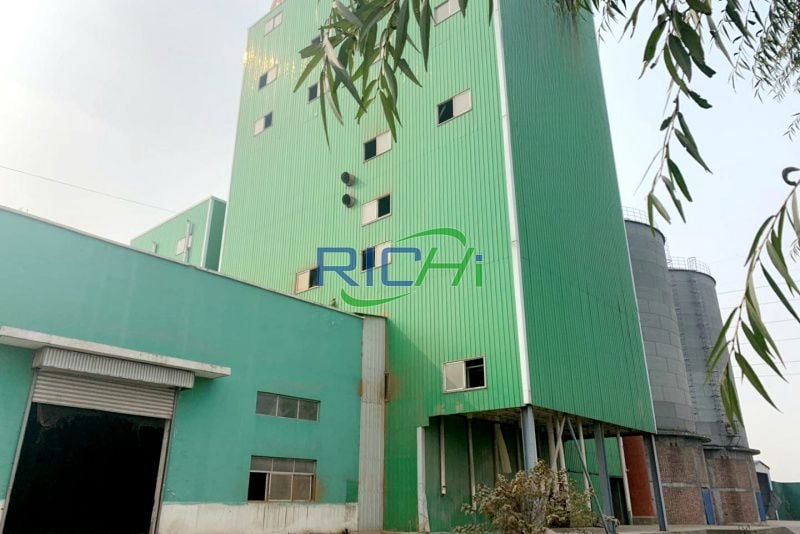
15-20T/H compound feed mill in Vietnam project
- Date: December 2020
- Feed type: pig & fish feed
- project cost: 500,000 USD
- compound feed equipment: crusher, mixer, pig feed pellet mill, floating fish feed extruder machine, cooler, baling scale, screener, silo system, etc.
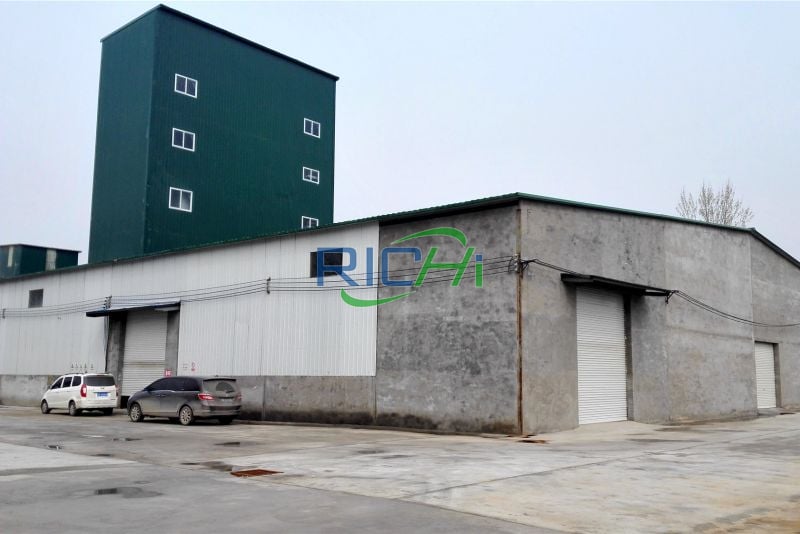
5-7 t/h compound feed mill in Mongolia project
- date: 2022.06.09
- Feed type: pig pellet feed
- project cost: 97160 USD
- compound feed plant equipment: Feed crusher, mixer, pig feed extruder, cooler, baling scale, screening machine, silo system, grease adding equipment, etc.
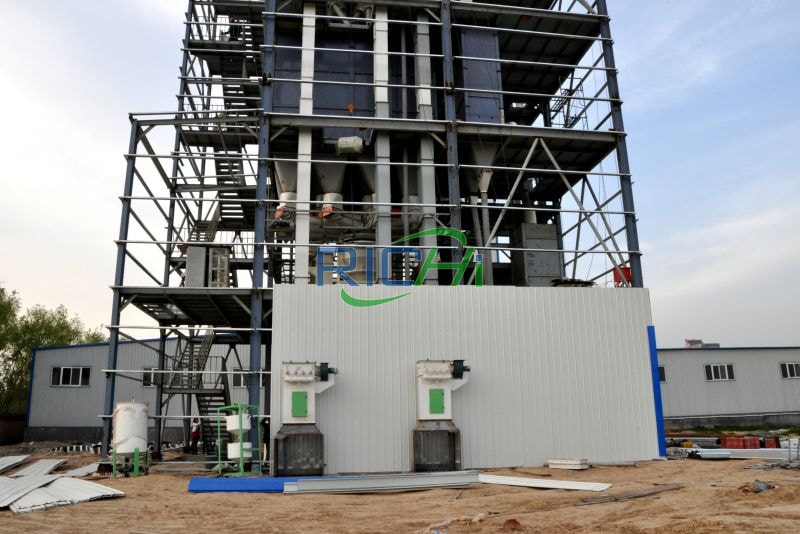
10T/H compound feed mill in the Philippines project
- Project date: 2018.09.13
- Feed type: pig & chicken feed
- project cost: 460,000 USD
- compound feed plant equipment: Feed crusher, mixer, feed granulator, cooler, baling scale, screening machine, silo system, boiler system, etc.
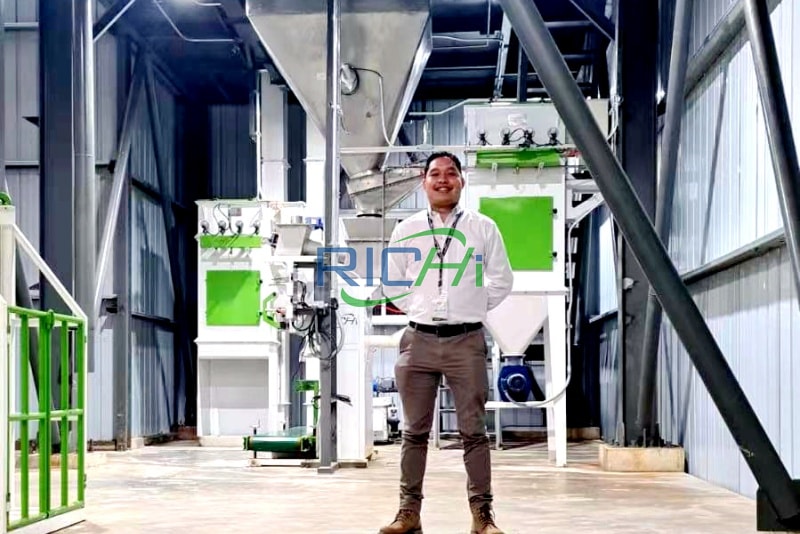
5 T/H compound feed plant In El Salvador project
- date: 2022. 09.13
- Feed type: pellet & premix
- project cost: 480,000 USD
- compound feed mill equipment: Feed grinder, stainless steel mixer, stainless steel batching scale, packaging scale, stainless steel silo system, boiler system, etc.
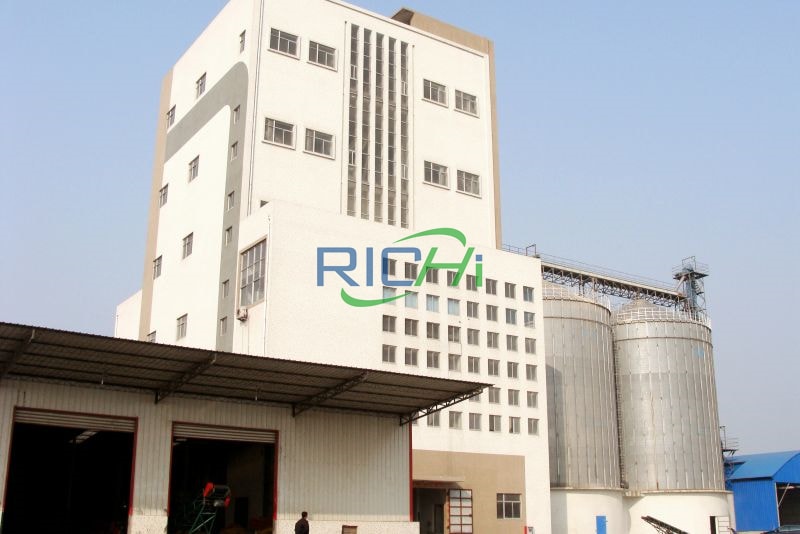
10 T/H compound feed plant In Thailand project
- date: 2021. 07. 22
- Feed type: chicken feed & premix
- project cost: 120,000 USD
- compound feed mill equipment: Ultrafine pulverizer, stainless steel mixer, stainless steel batching scale, packaging scale, silo system, boiler system, etc.
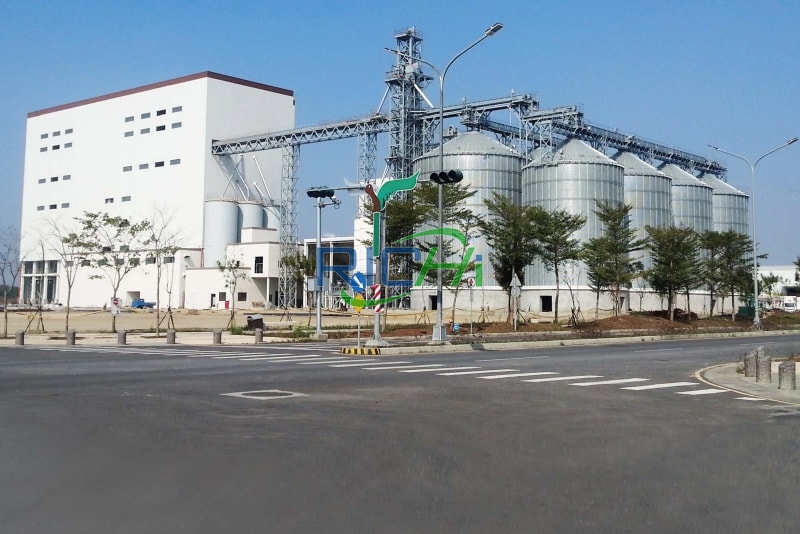
50T/H compound feed plant in russia project
- Date: June 2019
- Feed type: ruminant & poultry
- project cost: 960,000USD
- compound feed mill equipment: Feed crusher, feed mixer, batching scale, feed pellet mill, cooler, screening machine, baling scale, boiler system, etc.
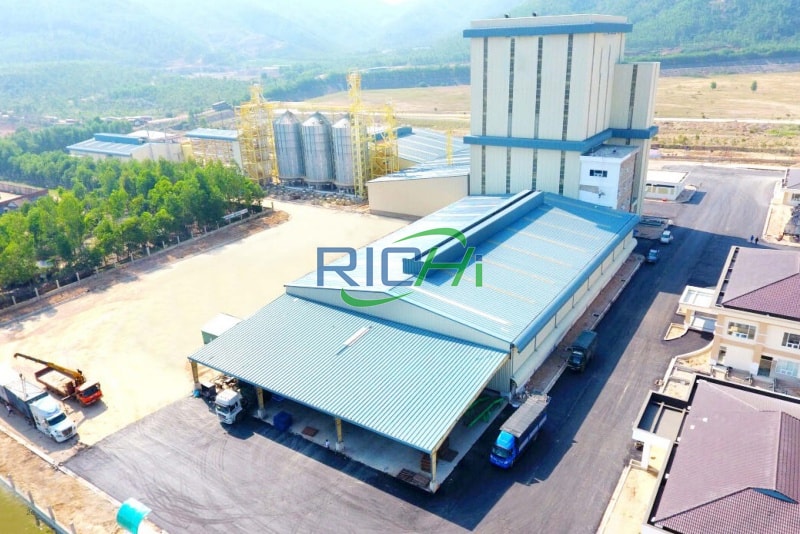
30T/H compound feed plant in Kazakhstan project
- Date: December 2018
- Feed type: poultry & stock feed
- project cost: 1,250,000 USD
- compound feed mill equipment: Feed crusher, feed mixer, batching scale, feed pellet mill, cooler, screening machine, baling scale, silo system, etc.
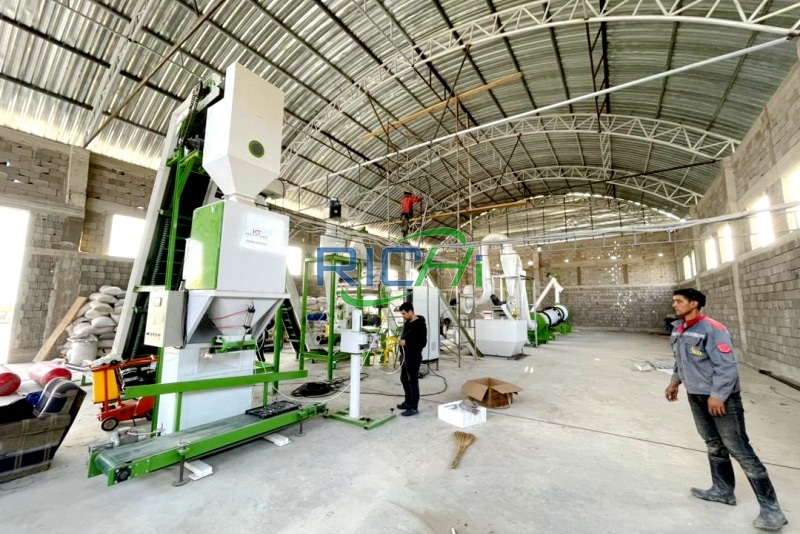
5 t/h compound feed factory in Argentina project
- Project date: 2021.10.11
- Feed type: chicken & cow feed pellets
- project cost: 184500USD
- compound feed mill equipment: Alfalfa grinder, feed mixer, batching scale, alfalfa granulator, cooler, screening machine, baling scale, silo system, etc.
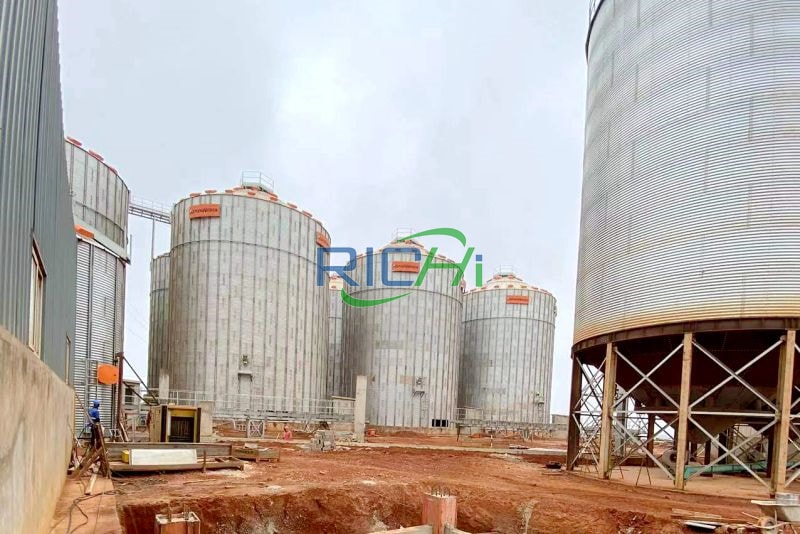
5-10 t/h compound feed factory in angola project
- Project date: 2022.10.14
- Feed type: hen & cattle & goat feed
- project cost: 131820 USD
- compound feed mill equipment: grass crusher, corn crusher, feed mixer, cattle and chicken feed pellet machine, cooler, screening machine, packaging scale, etc.
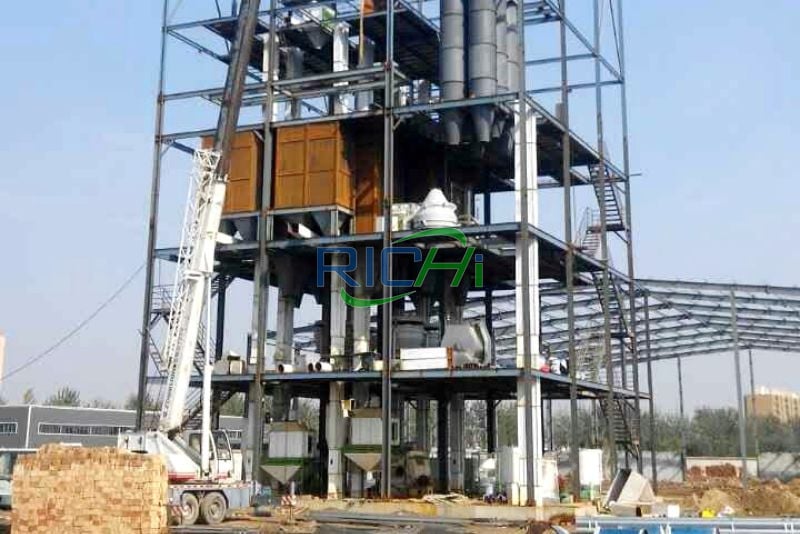
15 T/H compound feed factory In Uganda project
- Project date: 2022.06.30
- Feed type: cattle & aqua fish feed pellets
- project cost: 159070 USD
- compound feed mill equipment: Feed grinder, ultra-fine grinder, feed mixer, feed granulator, fish feed extruder, cooler, screening machine, packaging scale, etc.
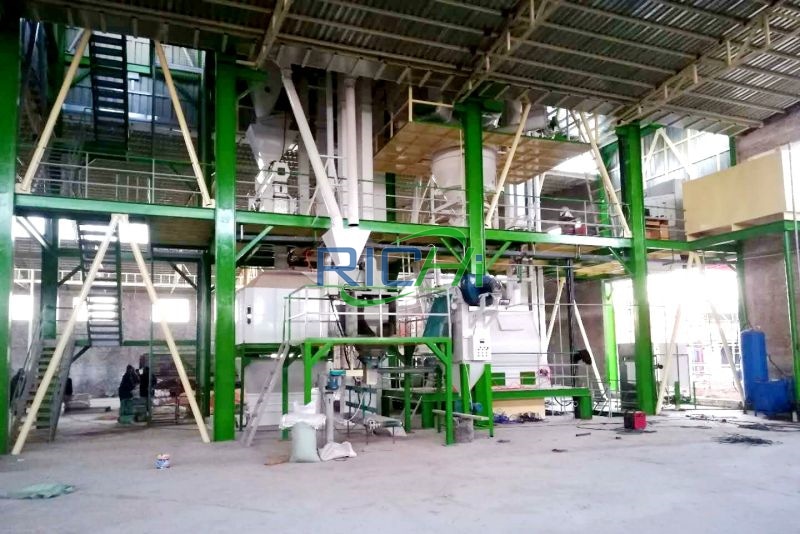
20T/H compound feed factory in united states project
- Project date: 2019.05.10
- Feed type: ruminant cattle pellet feed
- project cost: 550000 USD
- compound feed mill equipment: Bale breaker, grass crusher, feed mixer, hemp pellet mill, cooling machine, screener, baling scale, oil adding system, etc.
Featured compound feed mill factory design
Below are some unique compound feed factory designs we have made for different customer needs:
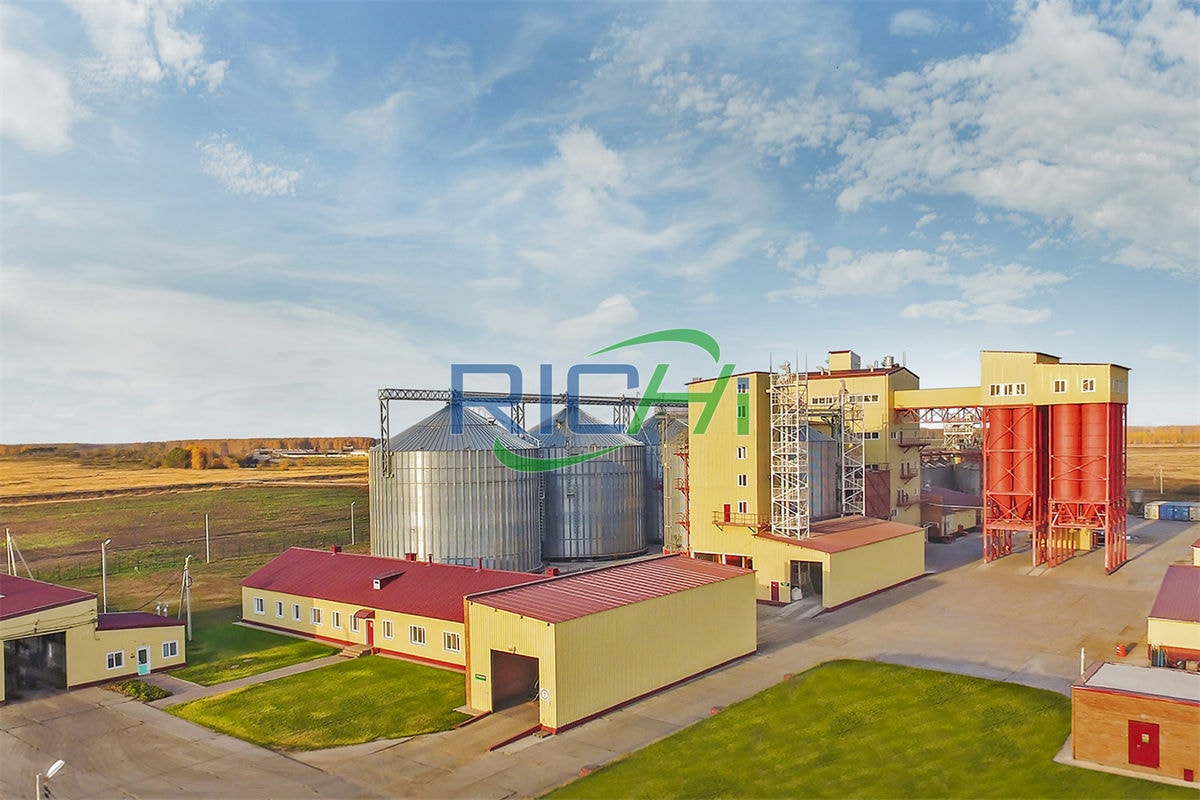
10 t/h compound feed mill for poultry chicken
The characteristics of poultry feed are moderate grinding fineness (screen aperture 2-4mm), moderate ripening and conditioning requirements (granulators mostly use double-layer conditioners), and large diameter of finished particles (particle diameter is about 2.5-4mm).
- The designed output of SZLH420 compound feed processing line is 10T/H;
- It adopts a crushing line, double-scale automatic batching, a mixing line, a granulating line and a packaging line;
- The total power of the poultry feed mill equipment is approximately: 390KW;
- The construction area of the production area is approximately: 16×11×26m;
- The compound feed line is equipped with a 1T boiler.
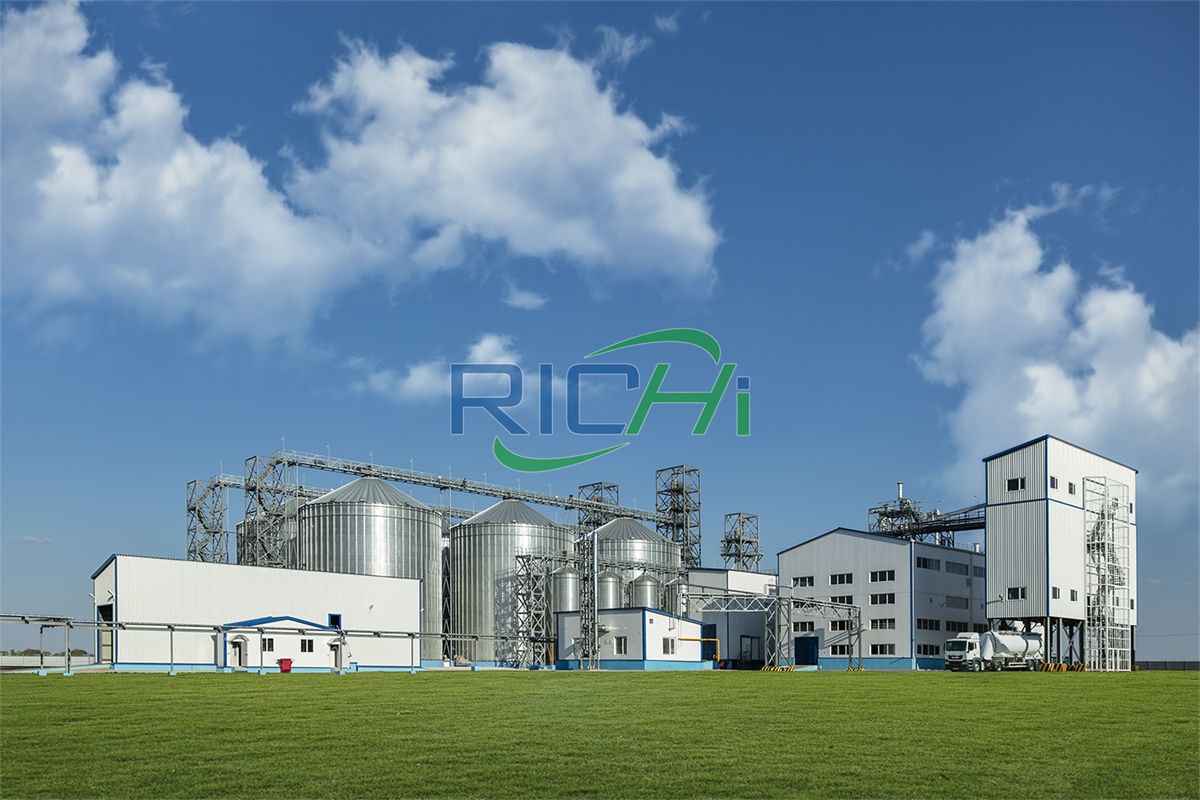
16-24 t/h compound feed mill for rabbit
The characteristics of rabbit feed are moderate grinding fineness (sieve mesh diameter 2-4mm), low requirements for ripening and conditioning (the rabbit pellet making uses a single-layer conditioner), and large diameter of the finished pellets (pellet diameter is about 2.5-4mm).
- The double sets SZLH508 rabbit feed mill is designed to produce 16-24 tons per hour.
- It uses a separate forage feeding line, two crushing lines, an ingredient mixing line, two pelleting lines and two packaging lines.
- The total power of the equipment is approximately: 800KW.
- The construction area of the production area is approximately: 18×18×29.5m.
- It is equipped with a 2T boiler.
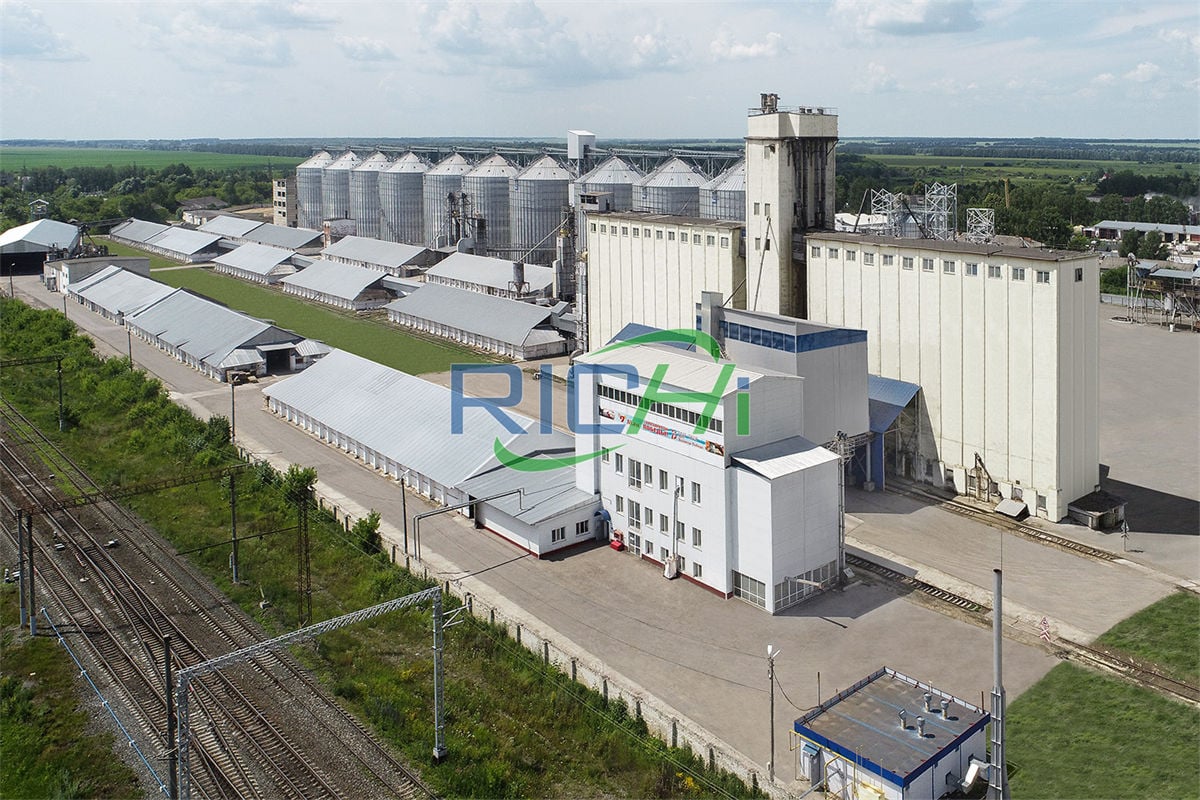
50-60 t/h compound feed mill for cattle and sheep
The characteristics of ruminant feed are coarse grinding fineness (sieve mesh diameter 4-8mm), low requirements for ripening and conditioning (livestock feed pellet mill generally use single-layer conditioners), and large diameter of finished pellets (pellet diameter is about 4-10mm).
- The three sets SZLH678 sheep cattle feed production line is designed to produce 50-60 tons per hour;
- Using three crushing lines, two batching mixing lines, three granulation lines and three packaging lines;
- The total power of the equipment is approximately: 1670KW;
- The supporting boiler is 4T;
- The construction area of the production area is approximately: 22.5*18*29.5m.
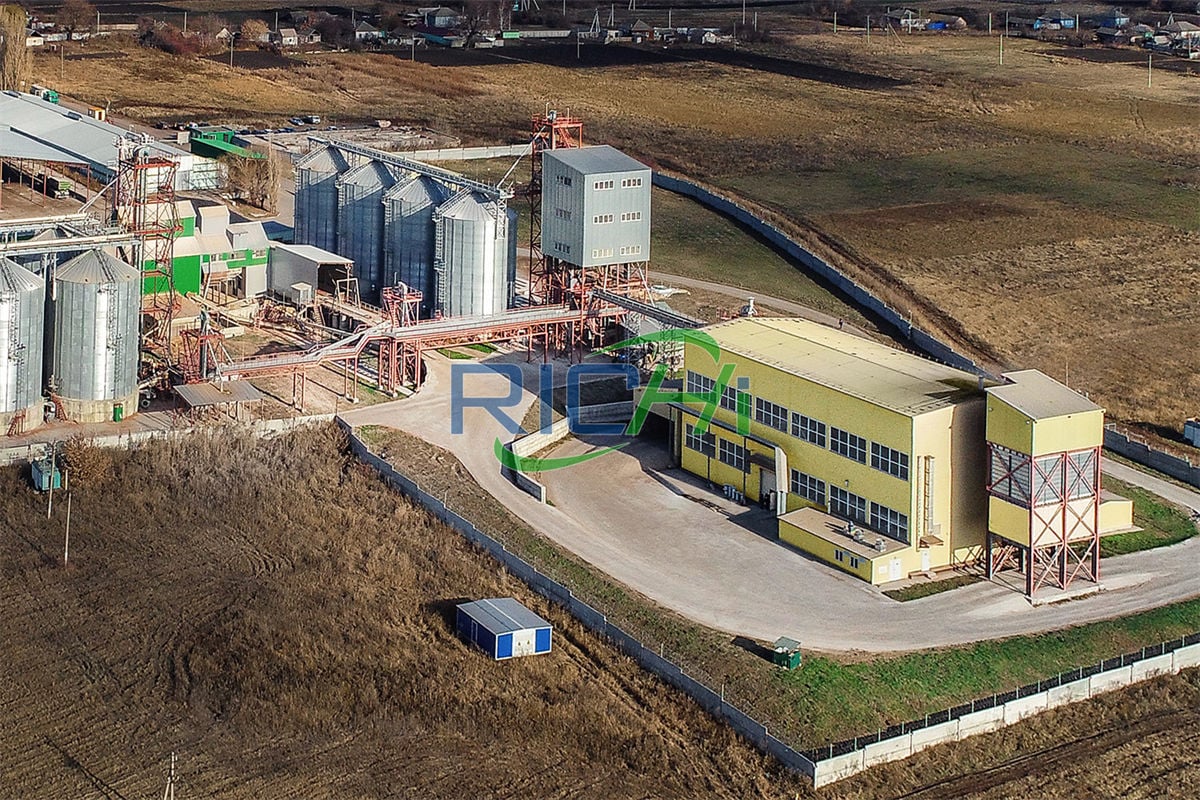
3-6 t/h compound feed mill for floating fish feed
The characteristics of expanded aquatic feed are fine grinding fineness (60-100 mesh required), high requirements for ripening and tempering, high oil content (using a combination of mixer + extruder + post-oil injection), and the range of finished particle diameters. Wide (particle diameter is about 0.6-20mm).
- The extruded fish feed mill is designed to produce 3-6 tons per hour;
- It adopts primary crushing, primary ingredient mixing, secondary ultrafine crushing, secondary mixing, puffing, drying, spraying, cooling, and final product packaging;
- The total power of the compound animal feed mill equipment is approximately: 450KW;
- The construction area of the production area is approximately 30x24x30m (height);
- It is equipped with a 2 tons per hour boiler.
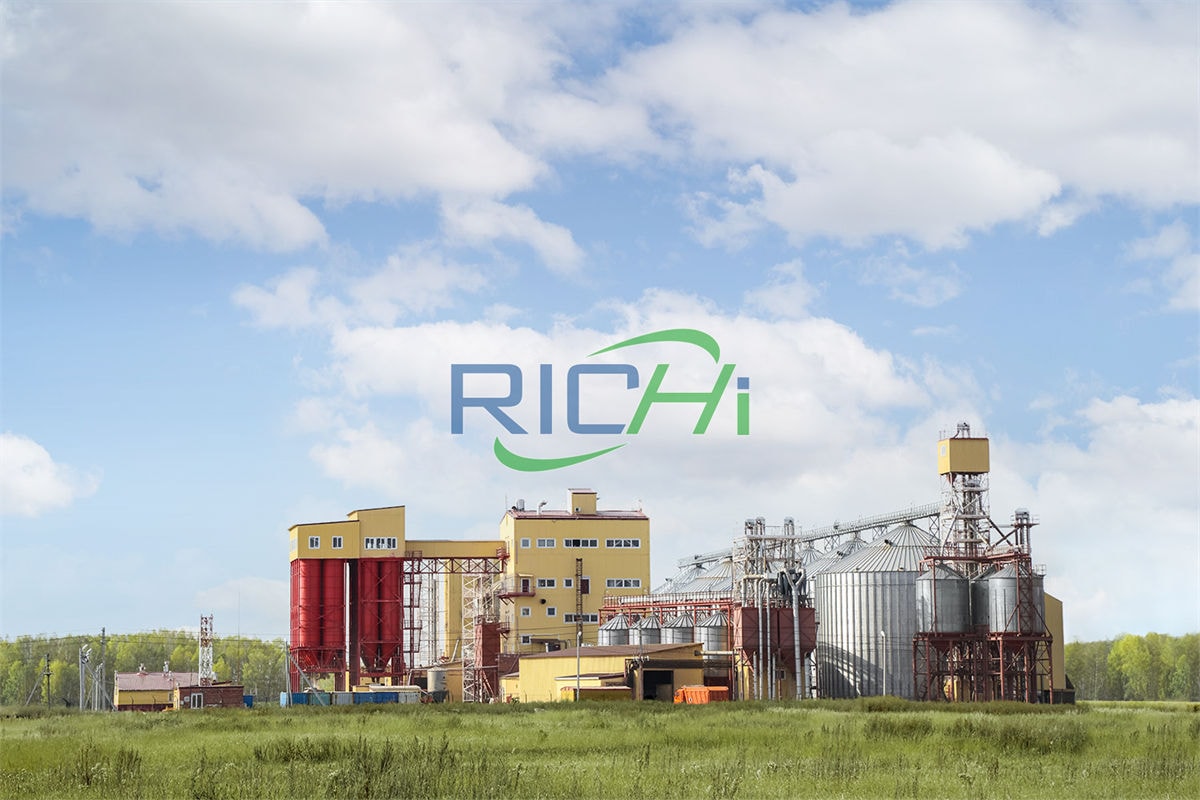
1 t/h compound feed mill for pet dog cat feed
The finished pellet sizes of cat food and dog food are large, and the grinding fineness of the raw materials is generally required to be 60 mesh, the requirements for conditioning are high, and the oil content is high. (Using a combination of mixer + pet food extruder + powder spraying and spraying), and the diameter of the finished particles ranges from about 2-8mm.
- Adopts the first batching and then crushing process, that is, one batching, one premixing, micro-grinding, two-time mixing, extrusion, drying and powder spraying, cooling and packaging of finished products.
- The total power of the compound feed mill equipment is about 275KW;
- The construction area of the production area is about 9×13.5×14.5m (height);
- It is equipped with a 0.5T boiler.
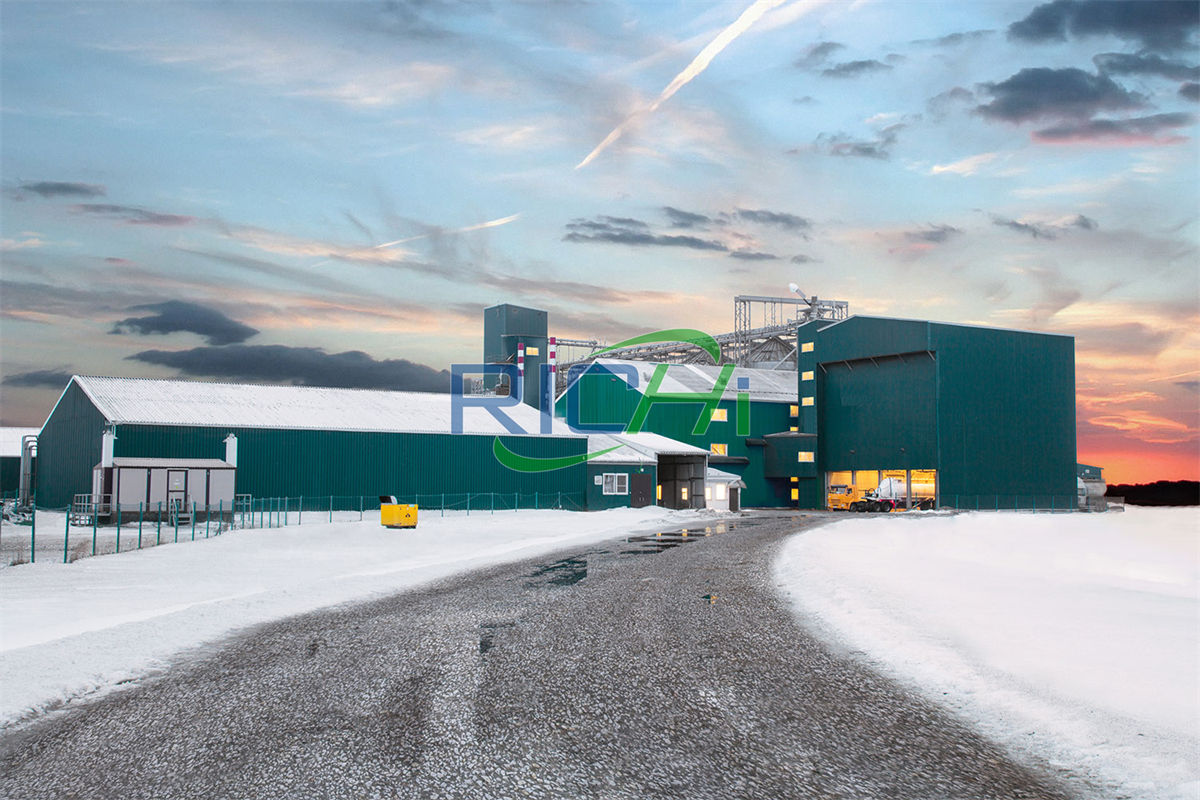
1.5-2.5 t/h compound feed mill for shrimp and crab feed
The characteristics of shrimp and crab feed are fine grinding fineness (95% of vannamei shrimp feed is required to exceed 80 mesh) and high requirements for conditioning (SZLH420 shrimp feed pellet machine adopts dual-shaft differential conditioner + quality maintainer + jacket conditioner), high water resistance (using post-curing process), small particle diameter of the finished product (particle diameter is about 1.0-2.5mm).
- The SZLH420 shrimp and crab compound feed milling plant is designed to produce 1.5-2.5T/H shrimp feed per hour;
- It adopts primary crushing, primary batching mixing, secondary ultrafine crushing, secondary batching mixing, a granulation line and finished product packaging;
- The total power of the equipment is about 605KW;
- The construction area of the production area is about 22×17.5×30;
- It is equipped with a 1T boiler.
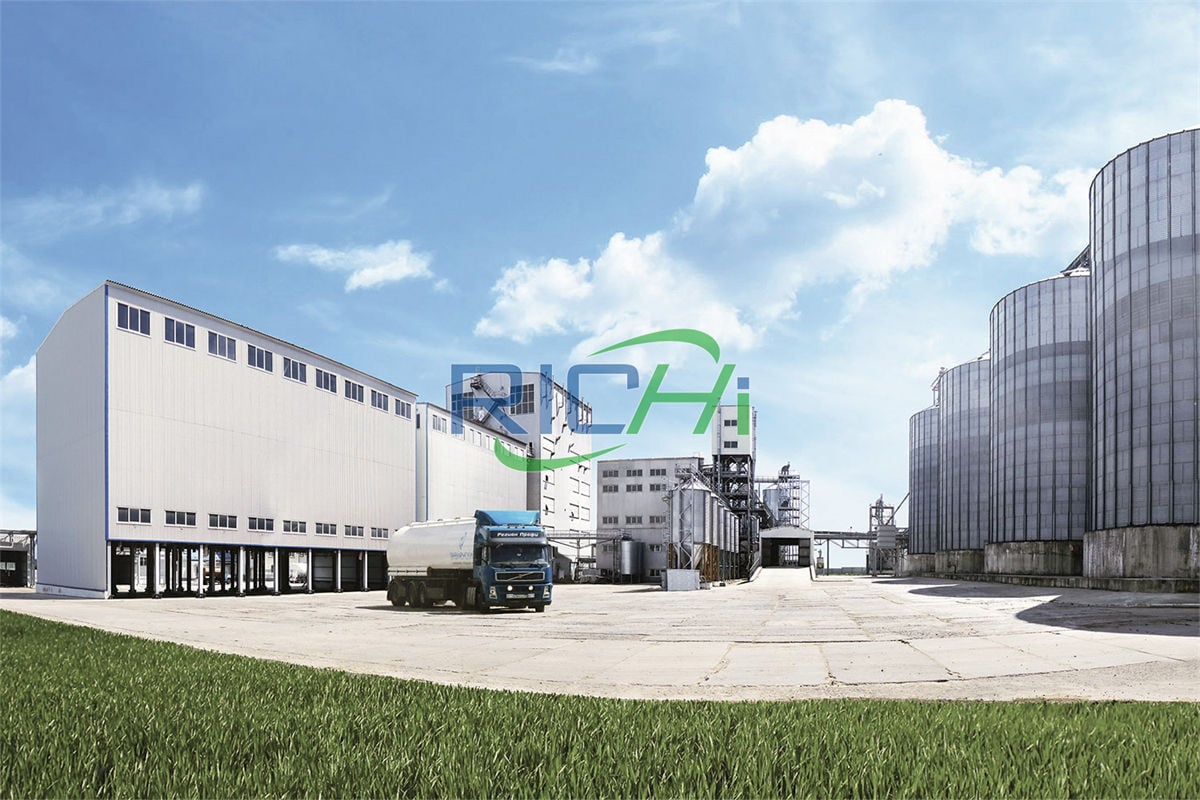
3 t/h compound feed mill for sinking fish feed
The characteristics of ordinary aquatic feed are fine grinding fineness (requires crusher screen aperture 0.8-2.0mm), high requirements for ripening and conditioning (using a double-jacketed conditioner), and small diameter of finished pellets (pellet diameter is about 2-2.0mm). 4.0mm).
- A single SZLH350 ordinary fish feed processing line is designed to produce 3 tons per hour;
- Adopts a single crushing line, a single batching mixing line, a single granulating line and a single packaging line.
- The total power of the equipment is approximately: 210KW;
- The construction area of the production area is approximately: 9.5×7×16.3m (height);
- Equipped with a 0.5T boiler.
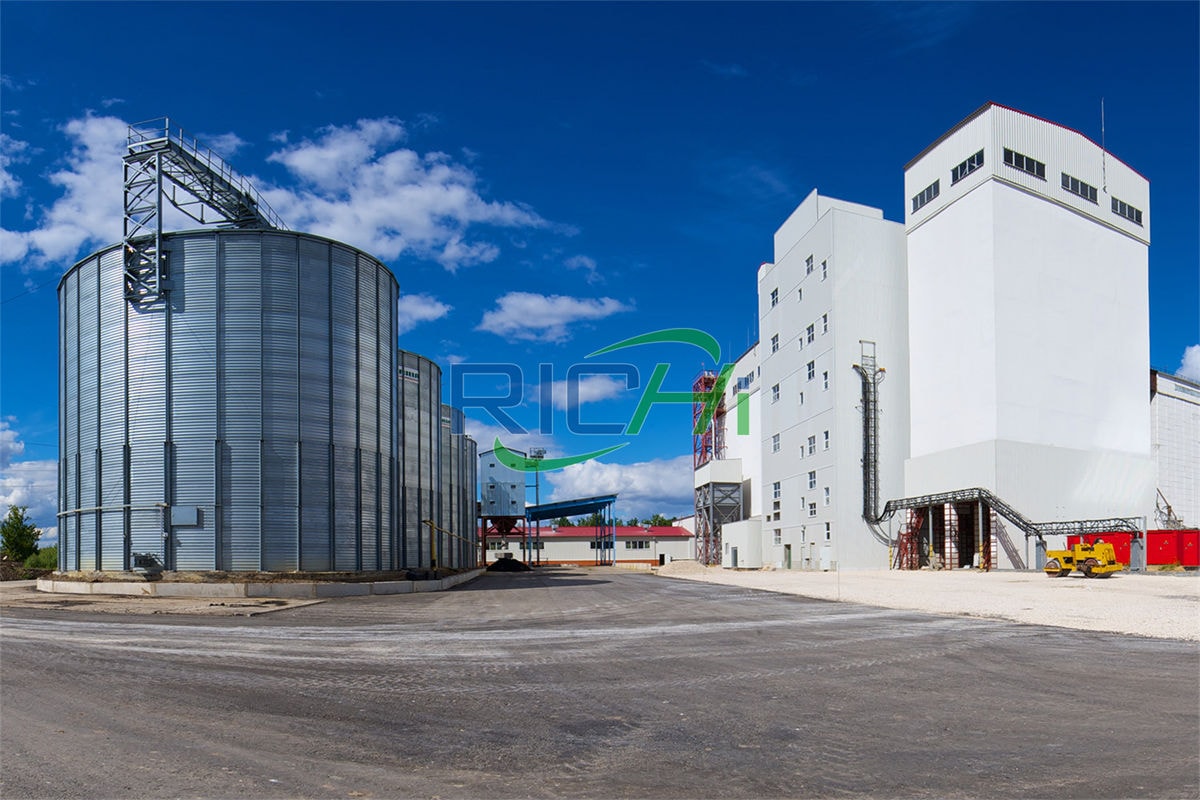
6-8 t/h compound feed mill for pig feed
The production characteristics of high-grade suckling pig feed are fine grinding fineness (screen aperture 1-2mm), high maturity requirements, low tempering temperature (using low-temperature granulation), and diameter of the finished pellets is about 2-3mm.
- Most of the raw materials are fully expanded (the raw materials are highly matured), and then secondary crushing, secondary mixing, and then low-temperature granulation are used.
- The SZLH420 high-grade suckling pig compound feed mill is designed to produce 6-8t/h;
- Uses a crushing line, a batching mixing line, an expansion line, a granulation line and a packaging line;
- The total power of the equipment is about 712KW;
- The construction area of the production area is about 19×17.5×29m;
- It is equipped with a 1 ton per hour boiler.
RICHI is one of the well known feed machine manufacturers, exporter and suppliers of compound feed mill in China. We have made rapid strides in the business owing to its innovative products. With us innovation and improvement is an ongoing process. We strive for unfailing reliability in all aspects of our business in product, delivery, service and support.
If you want to build a compound feed mill for compound poultry feed, compound cattle feed, compound aqua feed, compound pet feed, contact us to customize free compound feed mill plan that best suits your needs.
Compound feed mill cost
The investment in building a compound feed mill is a difficult question to answer, because the amount of investment depends on many factors, such as the size of the compound feed plant, equipment configuration, factory buildings, etc. Our customized compound feed plants typically fall within the following price ranges:
- 1-2 t/h compound feed plant cost: 10000-50000 USD
- 3-4 t/h Compound feed mill cost: 50000-120000 USD
- 5-7 t/h Compound feed mill cost: 70000-250000 USD
- 8-10 t/h Compound feed mill cost: 150000-300000 USD
- 12-20 t/h Compound feed mill cost: 250000-580000 USD
- 25-40 t/h Compound feed mill cost: 450000-850000 USD
- 50-60 t/h compound feed plant cost: 900000-1400000 USD
- 60-80 t/h compound feed plant cost: 1450000-1800000 USD
- 80-100 t/h compound feed plant cost: 2000000-2800000 USD
The following are the main factors that affect the cost of compound feed mills:
01 Compound Feed mill scale
The size of the animal feed mill is the primary factor in determining the amount of investment. Small compound feed mills are usually smaller in scale and have fewer equipment configurations, so the investment amount is relatively low; while large feed mills are larger in scale and have more complex equipment configurations, so the investment amount is relatively high.
Generally speaking, the investment amount of a small feed mill is tens of thousands to hundreds of thousands of dollars, while the investment amount of a large feed mill may be as high as millions of dollars.
02 Equipment configuration
Equipment configuration is another important factor in determining the amount of investment. Generally speaking, the higher the equipment configuration, the higher the degree of automation, and the higher the investment amount.
Therefore, differences in equipment configuration will also lead to differences in investment costs. In addition, the configuration of the silo system will also affect the final compound feed mill price.
03 Factory building
The factory building is another important cost in building a feed mill. Generally speaking, some customers purchase sites to build factories, while others rent factories. The rent of the venue depends on the economic development level of the area and the market supply and demand.
Generally speaking, venue rents in cities are relatively high, while rents in rural areas are relatively low. Therefore, site rent will also have an impact on the amount of investment.
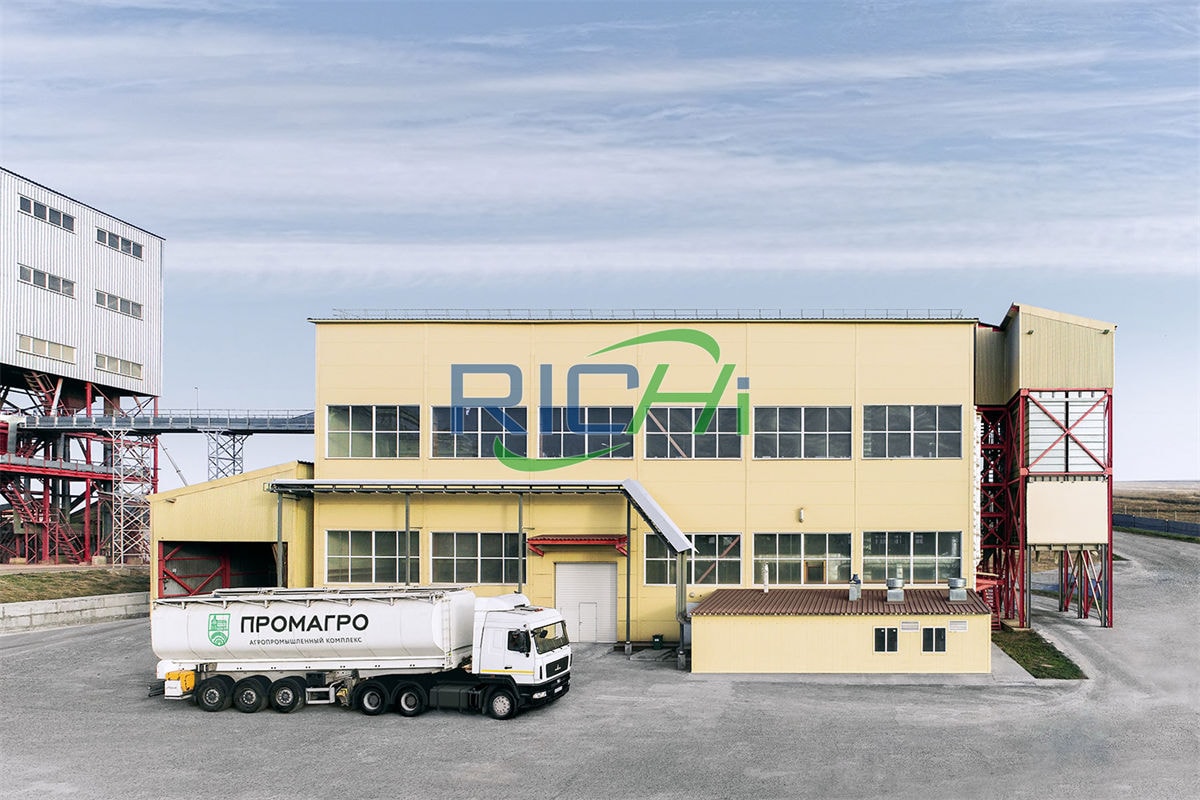
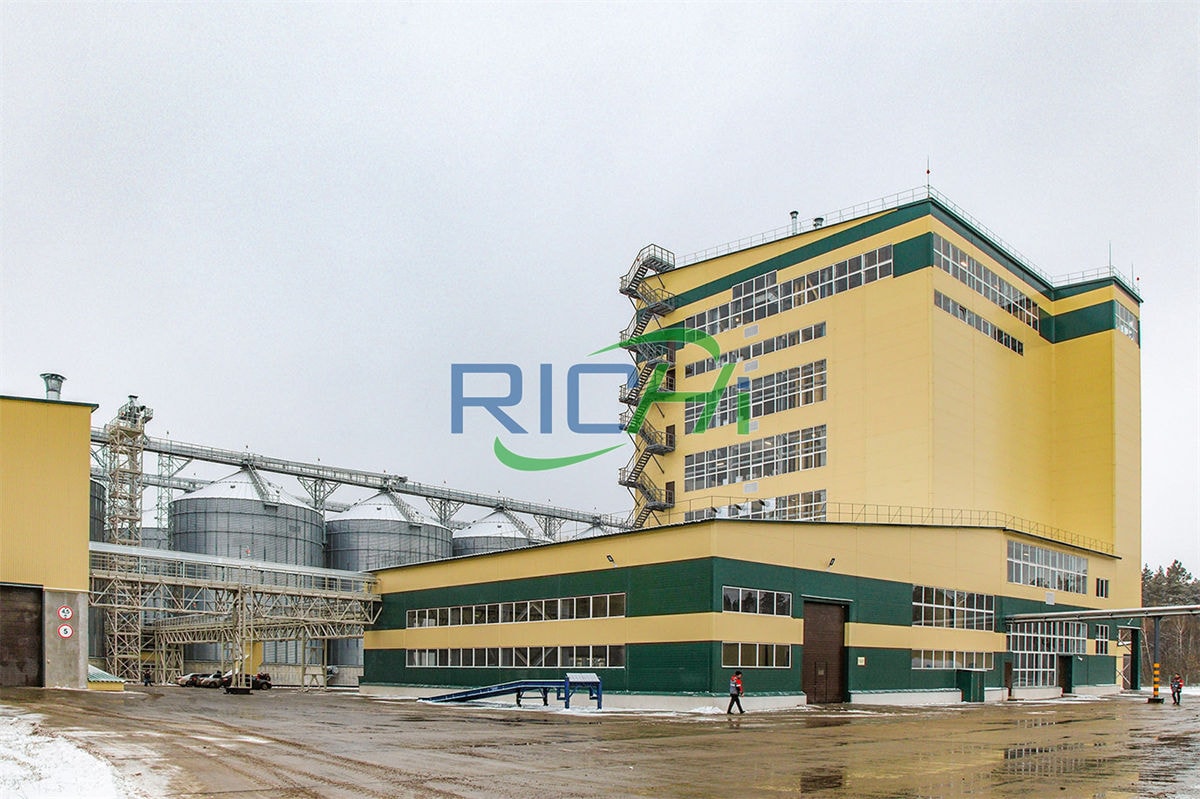
Generally speaking, the amount of investment in building a feed mill depends on many factors, such as the scale of the animal feed mill, equipment configuration, site rental, etc.
Therefore, if you intend to build a compound feed mill, it is recommended that you first understand the local market conditions and then make investment decisions based on your own circumstances.
Advantages of compound feed mill technology
- Functional design of factory building.
The compound feed factory is equipped with MCC power distribution room, computer control room, small material batching room, equipment maintenance room, etc., which facilitates the management of the production workshop. The overall design has a balanced layout and leaves room for expansion.
As long as the factory area remains unchanged, the purpose of expanding production can be achieved by making slight updates in equipment selection and changing specifications. - Select advanced, efficient and high-quality equipment.
In the design, the host equipment adopts advanced imported equipment, and other equipment adopts high-quality products produced by imported absorption and digestion supporting equipment.
In particular, the control system applies automated control and computer technology to improve the automation and modern management level of the compound feed mill. Realize automatic program monitoring and computer management of ingredients throughout the feed mill production process. - Ingredients are the heart of the compound feed factory.
The ingredient process has a great relationship with the cost, quality, output and operation and management level of the feed factory. The compound feed plants designed by RICHI are equipped with batching computers to realize process program control from batching to mixing and ensure the stability of batching accuracy, ensuring that the uniformity of the mixture is within the specified range. - Achieve automatic program control of the entire process of compound feed production.
The entire compound feed mill production process automatic control simulation screen in the central control room controls the six major processes of raw material receiving, crushing, batching and mixing, granulation and finished product packaging in both manual and automatic states.
Control and monitoring, and have sound and light warnings for motor failure, valve failure, stalling of conveying equipment, motor short circuit, warehouse full and other faults, so as to nip hidden troubles in the feed production process in the bud and reduce equipment failure rate and Maintenance costs are reduced, labor productivity and management level are improved. - In the design of the batching plant, special attention should be paid to taking measures to deal with noise, dust, etc., so that compound feed mill workshop production meets the environmental protection requirements of the compound feed industry.
For ultrasonic and vibration equipment, they are arranged separately in a reinforced concrete mixed structure room, and isolation measures are adopted to separate them from the steel structure main car bay to control workshop noise. Take strict sealing measures for all operating equipment to prevent dust from escaping. Use stand-alone vacuuming for equipment that cannot be sealed to ensure that the dust concentration in the workshop is lower than the industry-stipulated 10mg/m3. - The RICHI process is equipped with conditioning, curing, puffing, pelleting, cooling and drying, crushing and other processes, which makes this process more flexible in operation, has strong adaptability to multiple varieties of feed processing, and can improve the feeding effect.
Since after granulation, large particles and agglomerated materials are removed through a classification screen, the quality of the finished feed can be better ensured. Furthermore, it is equipped with a liquid addition system to make the process more complete and more adaptable.
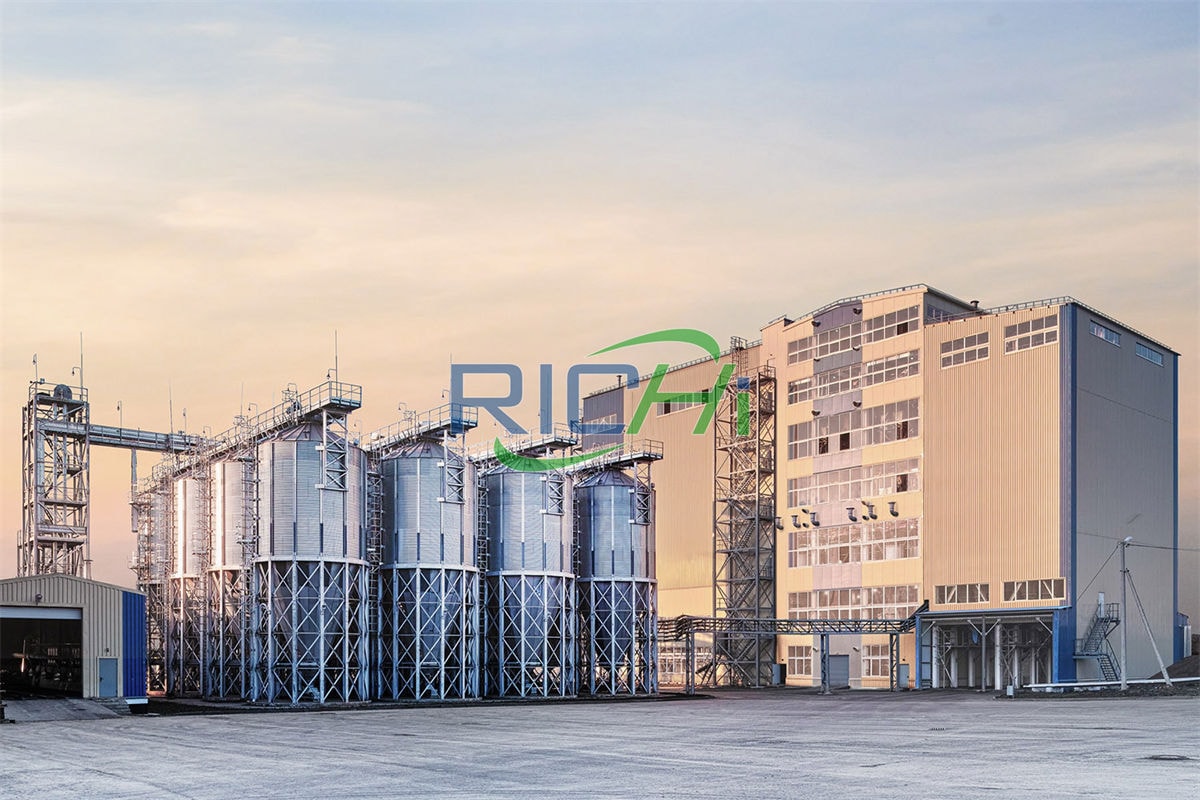
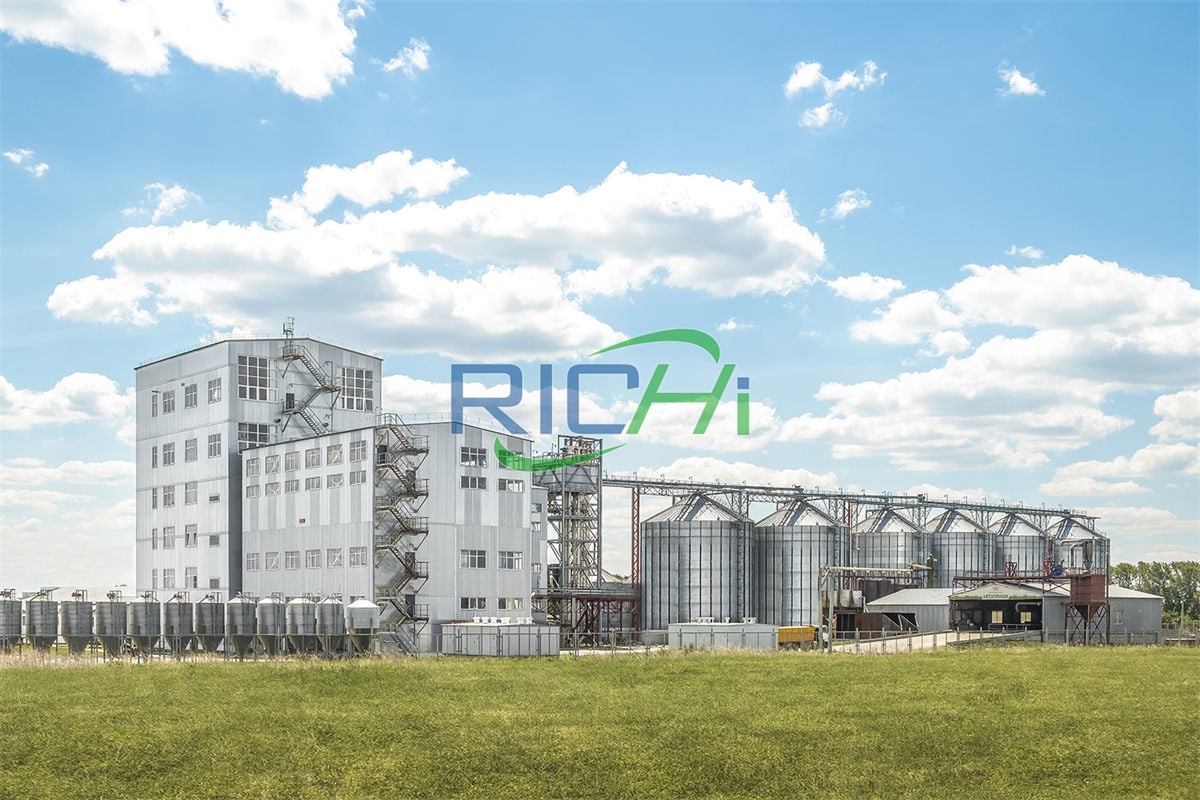
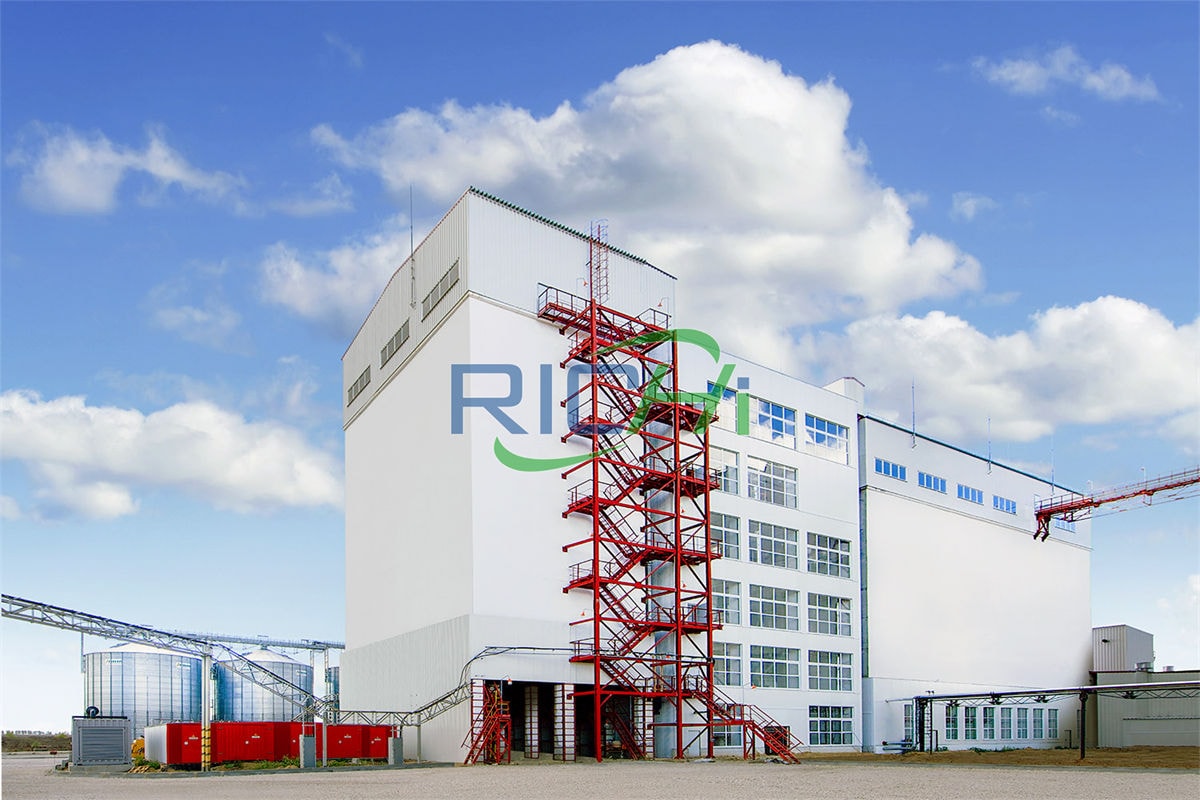
In short, RICHI’s compound feed processing technology and equipment have been developing, and it has been working hard to develop the manufacturing processes and electromechanical equipment required for complete sets of compound feed mill projects with its own characteristics.
Being a renowned manufacturer across the Asia, we are engaged in manufacturing the optimum quality compound animal feed production line and compound fish feed production line, offered range is highly appreciated by our valued customers for its durability and dependability. Our range of these machines is offered in different models to suit against different requirements of our clients.
Prospects for compound feed production
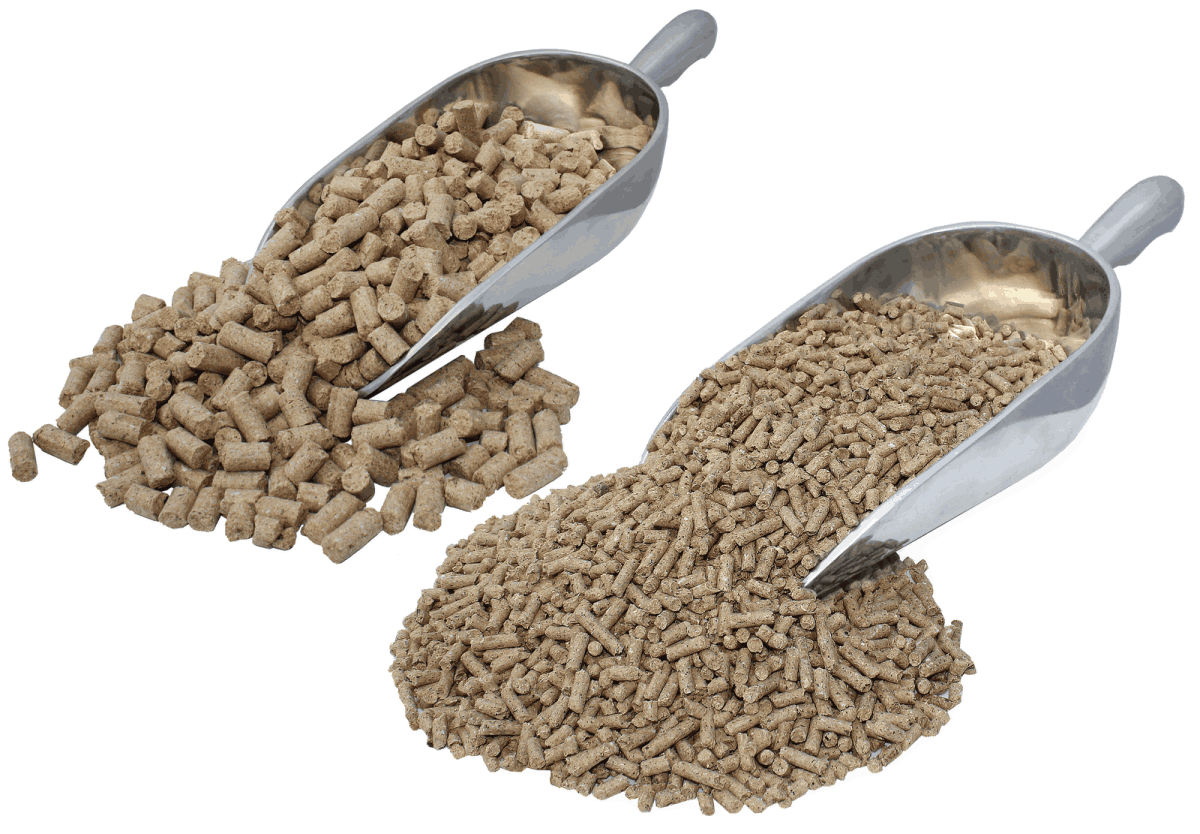
As the global population grows and income levels rise, demand for animal products will continue to grow. At the same time, as people pay more attention to food quality and safety, the demand for high-quality compound feed will also increase, giving the feed processing industry more opportunities.
The compound feed industry is an industry with huge potential and high development prospects. As people have higher and higher requirements for nutritious, safe and healthy food, feed plays an increasingly important role in animal husbandry. At the same time, various countries are increasing their support for agriculture, and the feed processing industry has also received more policy support and investment.
In the future, the compound feed industry will show the trend of scale, specialization and intelligence. Large-scale compound feed mill enterprises will gradually rise and develop in a diversified direction, improving product quality and competitiveness through independent innovation and technological progress.
At the same time, the cooperation between feed processing enterprises and other links in the agricultural industry chain will be further strengthened to form an industrial ecosystem with coordinated development.
In short, the compound feed production will face many opportunities and challenges in the future. Through efforts in technological innovation, market development and environmental protection, the compound feed production will be able to achieve sustainable development and make greater contributions to agricultural production and people’s lives. (Find RICHI on YouTube)
Compound feed mill Videos
our service
Specialization achieves personalization. Based on the business philosophy of “earning trust with sincerity and winning with quality”, RICHI pays close attention to the differentiated needs of customers, tailors each complete compound feed mill, and continues to create personalized value for customers.
Compound feed mill engineering
Pay attention to human health, advocate the perfect combination of “low energy consumption, low cost” and “automation, high efficiency”, provide customers with overall solutions for “producing clean and safe feed”, and then provide the society with various breeding, Aquatic products and other safe foods provide one-stop service “from farm to table”.
Warehousing machinery and engineering
Suitable for industrial fields such as grain, feed, oil, flour, brewing, building materials, chemicals, port environmental protection, etc., to solve problems such as high labor intensity, large area, high cost, difficult storage and transportation, and difficulty in controlling temperature and humidity. Achieve “large capacity, automation, and intelligence” storage and transportation.
RICHI compound feed mill engineering keeps up with the forefront of high-end design in the industry, actively explores, boldly innovates independently, optimizes and improves, and meets the customized needs of customers to the maximum extent while meeting safety and environmental protection requirements.
Faqs of Compound feed mill

How to build a compound feed mill?
1. Project cost:
Many other costs involved in the project other than compound feed mill like boiler, transformer, genset, civil work, taxes, transportation, Weigh Bridge, ware house, building construction, working capital etc. Hence considering all the costs in the project report is an essential .
2. Market area (Radius of 200 kms) :
Future trends and concentration of livestock, poultry and other animal production, demand & availability of feed, demand & availability of raw material, grain surplus or deficit area, kind of feed grains grown and fed, future trends in feed potential etc.
3. Competition in market:
Kinds & prices of feeds sold, credit policy of competitors, services offered to customers, share of local market, man power availability & cost, nature of farmers & traders, discount policy, trend of on-farm grinding and mixing.
4. Selecting the compound feed mill site:
Condition of roads, availability of power, water and manpower, drainage & nature of soil, water level, federal and local regulations for pollution & air quality, attitude of local people and government towards a new feed manufacturing unit, taxation and subsidy rules etc. All these factors must be taken into consideration while selecting a site for compound feed mill.
5. Project feasibility:
Raw Material Cost+ Processing cost + Packaging + over heads = Total Cost of production
Where raw material is grains like Maize, Soya, Mustard, GNE, Cakes, DORB, Oils, Molasses, Medicines, Supplements etc.; processing cost involves Boiler Fuel, Electricity, Labour, Maintenance, general Wear & Tear; packaging cost for PT Bags and overheads are depreciation, bank interest, salaries, promotions & branding etc.
Hence all above factors effects the cost of compound animal feed processing plant production and considering all these factors along with working capital, selling price & profits we can easily calculate the project feasibility & return on investment.

How to design compound feed mill layout?
The complexity and simplicity of the overall layout of the compound feed mill are closely related to the production scale and requirements.
For large feed mills, in order to operate normally, they must not only build production workshops equipped with reasonable feed processing technology and equipment, but also build matching vertical cylinder warehouses, raw material warehouses, finished product warehouses, and transformation equipment closely related to production.
There are auxiliary facilities such as electrical rooms, machine repair workshops, boiler rooms, material warehouses, and weighbridge rooms, as well as office and living facilities such as office buildings, laboratories, and dormitories.
The layout of these building facilities affects the production management and efficiency of the compound feed factory.
- Whether the logistics within the animal feed production plant is reasonable is a thorough and measured issue and an important basis for the success of the overall layout of compound feed mill.
- In particular, major buildings such as feed production workshops, vertical silos, original (auxiliary) material warehouses, and finished product warehouses should be arranged according to the compound feed production process.
- The distance of the transportation line from raw materials to finished products should be shortened as much as possible to avoid round-trip transportation of materials.
- At the same time, the flow of raw materials, finished products, and people should have their own routes, strive to avoid intersections, and minimize the area occupied. The spacing between buildings must also meet fire protection, health and safety requirements.
- Due to land acquisition conditions, newly built compound feed mill factories often have irregular polygonal boundaries around the factory area.
- The production area should be arranged in the middle of the factory area as much as possible, and the surrounding corners should be fully utilized to arrange auxiliary facilities to meet production requirements.
- At present, the layout of major buildings such as compound feed mill raw material warehouses, processing workshops, and finished product warehouses mainly adopts two forms: sub-item connection layout and cluster combination layout.
- The sub-item connection arrangement means that the production workshop, original (auxiliary) material warehouse, finished product warehouse, etc. are constructed independently of each other, and the main workshop is connected to each warehouse. Connected through corridors, trenches or overpasses to form an overall combination form.
Each building in this arrangement has better ventilation and lighting performance, but it covers a larger area, has long material transportation lines during processing, and is uneconomical due to high transportation costs.
The cluster combination layout is an organic combination of the main workshop, raw material warehouse and finished product warehouse, which are separated from each other by walls. It has the advantages of high site utilization, short transportation operation lines, and flexible arrangement of functional units. However, the workshop ventilation and lighting conditions are poor.
We propose to make a compound feed mill layout solution:
- For your productivity
- For your compound feed types and recipe
- For your premises
- For your power generation conditions

What are the components of a compound feed mill?
Generally speaking, a complete compound feed factory mainly consists of the following buildings and facilities, and all of these buildings and facilities are within the scope of RICHI’s process design and construction.
- Production workshop: feed processing workshop (main workshop) and premix processing workshop.
- Auxiliary workshops: mechanical and electrical, instrument repair, weak current control room, laboratory, etc.
- Warehouse: raw material warehouse, vertical cylinder warehouse (steel plate warehouse), finished product warehouse, equipment warehouse, etc.
- Power facilities: power distribution room, boiler room, air compressor station, etc.
- Administrative living buildings: administrative buildings, canteens, dormitories, bathhouses, etc.
- Transportation facilities: roads, garages, etc.
- Engineering and technical pipeline network: various pipelines such as water supply, sewerage, power supply, compressed air, steam, etc.
- Greening facilities and architectural sketches: walls, gates, guard rooms, pools, lawns, flower beds, publicity bulletin boards, bicycle sheds, disinfection pools, fire-fighting facilities, etc.
According to the customer’s needs, factory space, site area, investment budget and other factors, the final composition of the compound feed mill factory is quite different!

How to choose the method of receiving and storing raw materials for the compound feed mill?
Feed raw materials can be divided into pellets and powders in form, bulk and bagged in terms of packaging, and can be transported by cars, ships and trains in terms of transportation methods.
Raw materials with different shapes, packaging and transportation forms will have different receiving and storage methods. However, applicable and advanced processes and equipment should be used to ensure that the receiving speed and capacity meet compound feed mill production needs, reduce workers’ labor intensity, and reduce costs of production.
- For granular raw materials such as corn and wheat, large livestock and poultry feed factories should be equipped with vertical silo raw material receiving systems to achieve a high degree of mechanization for receiving, storing, and discharging pellets, eliminating the need for manual labor at all.
- For powdery raw materials such as meal and DDGS, due to poor fluidity, easy arching, hardening, and difficulty in exiting the warehouse, most compound feed mill factories still use bags and rely on manual handling and feeding. However, with the expansion of the production scale of compound feed plants, the storage and feeding of such raw materials continue to be manual.
This not only requires high labor intensity for workers, but also seriously affects production efficiency and restricts further expansion of production scale. The use of silo storage is an inevitable trend. . - Soybean meal, etc. are stored in silos, which can realize bulk receipt of materials and automatic discharge from the warehouse without labor factors, reducing water loss and cross-contamination. However, the discharge problem must be considered to prevent poor flow, formation of hardening, arching, and inability to flow.
Therefore, for small silos with a smaller capacity (200~300 t), the silo outlet can be designed in a rectangular shape, with single, double, or triple screw discharges depending on the size of the silo; for large silos with a capacity of more than 1,000 t , must be equipped with an active discharge system to ensure the overall flow of materials, first in, first out, and complete discharge.
Other raw materials that are not suitable for storage in warehouses (such as bran, rice bran, fish meal, etc.) should be packed in bags, unloaded on pallets, transported by forklifts, and fed manually. This can improve the efficiency of raw material supply in the compound commercial feed mill production process, reduce human participation, and facilitate energy saving.

How to choose the intra-factory logistics and transportation method that matches the feed factory?
The in-factory logistics and transportation methods and transportation efficiency of compound feed milling plants are closely connected with the reception and storage methods of raw materials and the delivery methods of finished products.
The raw materials stored in silos can be directly sent from the silo to the bin to be crushed or the batching bin through conveyor equipment such as scraper conveyors and bucket elevators when feed needs to be made during the production process, eliminating the need for manual labor at all, realize the mechanization of feeding.
If all the raw materials that can be put into the silo are stored in the silo, the amount of manual transportation and feeding can be greatly reduced, the feeding efficiency can be improved, and the raw material warehouse area and labor costs can be reduced.
The feed products are in bulk, so there is no need for manual packaging and transportation. They flow directly from the bulk finished product warehouse to the bulk transport vehicle, which will greatly improve the delivery efficiency and reduce the finished product warehouse area and labor costs.
However, most compound feed companies currently only have granular raw materials entering silos, and the finished products are still packed in bags. Manual loading and unloading are widely used.
What kind of in-factory logistics transportation method should be used to minimize the cost and time during the transportation process, and at the same time reduce the cost of transportation? It is very important to reduce labor intensity and improve personnel work efficiency.
- The material handling work in the complete feed mill plant mainly includes the unloading, warehousing, palletizing, and outbound loading of raw materials, the warehousing, palletizing, and outbound loading of finished products, the handling and feeding of small materials, and the unqualified materials. Transportation and stacking of products, cleaning materials, etc.
- Material transportation methods in the compound feed factory mainly use forklifts, forklifts, motorized flatbeds, trolleys and other transportation vehicles and mobile belt conveyors, which are flexible and easy to use.

What factors will affect the quality of feed products in compound feed mills?
Compound feed quality management is the central link in enterprise management, and it is the control of key aspects of products from raw material management, production and processing, formula design, and after-sales service. Feed quality management is an important and regular task for compound feed enterprises, and it is also a necessary measure to improve production, promote sales, and increase efficiency.
1. Quality control of raw materials
- Pre-control of purchasing raw materials
The principle of high quality and low price should be followed, which can not only improve and stabilize product quality, but also effectively reduce production costs, thereby improving economic benefits. The purchasing department provides supplier samples, which can be purchased after inspection and confirmation.
- Control of intermediate samples
During the unloading process of raw materials, intermediate samples must be taken for inspection to prevent adulteration.
- Check the quality of raw materials in the batching warehouse daily
Raw materials in the batching warehouse can be produced after being inspected and confirmed every day. Samples are taken for confirmation at any time during the compound feed mill production process to prevent errors such as mixing warehouses.
- Check the quality of raw materials in stock every week
Compare with the current recipe requirements to check the difference. Check the temperature, moisture, mildew and other abnormal conditions of the stored raw materials, and deal with any problems in a timely manner.
2. Quality control of formula design
- Market research, information collection and processing
First, we must collect the growth performance, development status and competitor information of animals to design formulas for different varieties and grades.
- The designed formula must be competitive in terms of feeding effect and cost.
Only by choosing good palatability, taking into account the physiological characteristics of animals and the actual needs of customers, and using high-quality raw materials that are cheap and nutritious can we be competitive.
- The designed formula should be combined with the production process to ensure processing quality
The raw materials used must be reasonably matched, and the formula suitable for the process parameters should be designed according to the compound feed mill production process.
3. Quality control of the production process
- Sampling inspection
Each variety must be sampled to check its protein, moisture, etc. at the beginning, process, and end of production. Especially for granular materials, the frequency of testing should be increased to observe changes in moisture.
- Control of granulation process
It is necessary to check the modulation temperature of pellet materials to ensure that the modulation effect meets the quality requirements. When starting production of each variety, check whether the cooler is leaking to prevent the generation of hot materials.
- Packaging positions
Check the temperature, color and odor changes of the materials at any time, compare them with standard samples, and report any problems found in a timely manner.
4. Quality control of storage and transportation
- Shelf life
All products must comply with the quality regulations on the shelf life of the compound feed mill. Products that have exceeded the shelf life will be inspected by the quality control department before being disposed of.
- Regular inspection
The custodian should check the warehouse regularly and deal with any problems in a timely manner.
- Innovate and innovate
The custodian should know the production date of the feed and adopt the principle of introducing new products when shipping to prevent the backlog of old products.
5. After-sales technical service management
- Create customer profile
The content includes: customer name, mailing address, person in charge of the unit, contact number, breeding species and scale, technical strength, materials used, etc.
- Solve technical problems in a timely manner
When a customer has a problem and reports it to the salesperson, it must be reported to the quality control department for analysis and resolution. You must not do errands, be irresponsible and cause losses to the customer.
- Develop new customers through information feedback
The best way is for customers to introduce customers to gain trust more permanently.
The quality of feed products is a comprehensive reflection of all the work of compound animal feed factory. Strengthening quality management, ensuring and improving the quality of feed products will bring greater development space to feed enterprises.

How should compound feed mills handle and store feed raw materials?
Feed is the largest cost item in livestock production, accounting for 60 to 80% of the total cost of pig and poultry production. Therefore, we must purchase high-quality feed ingredients from the beginning. Once purchased, feed ingredients must be properly handled and stored to ensure that their quality does not deteriorate over time.
The quality of feed has a huge impact on animal performance. Moldy or rancid feed contains mycotoxins, free radicals, odors and moldy feed, which can harm animal performance, such as reducing animal growth rate, feed utilization and feed intake. Mycotoxins can also harm reproductive performance and suppress an animal’s immune system, for example causing abortions in pigs and weakening the response to vaccination in poultry.
Factors that are not conducive to safe storage of feed:
1.Bulk storage and bag storage
The storage method of feed ingredients can have a significant impact on their quality. Feed ingredients can be stored in bulk or in bags, both of which have their own advantages and disadvantages. In developed countries, feed ingredients are usually stored in bulk.
The advantages of bulk storage are:
- Can better control storage conditions;
- Labor input can be reduced in storage and handling;
- Can implement “first in, first out” inventory management;
- Both for feed raw materials and compound feeds, the cost of bulk transportation is lower;
- It can avoid the use of bags that are more expensive and may spread diseases;
- The transportation of feed in feed mills and farms can be mechanized, thereby reducing labor input;
- Bulk transportation of feed is beneficial to the biosecurity of the farm.
In developing countries, feed ingredients and compound feeds are usually stored in bags due to lower labor costs.
2.Bag storage also has its advantages and disadvantages
No need to invest in equipment such as silos, transmission systems, scales, etc.;
- In places where labor is cheap and abundant, the costs of transportation and storage are relatively low;
- It is difficult to implement the “first in, first out” approach;
- It is impossible to provide air supply and ventilation, so the temperature of the stored materials cannot be controlled;
- Feeds stored in bags are prone to insects, mold and rancidity because the bags cannot protect the feed well from environmental changes;
- The cost of bags is very high, and bags can also become a source of contamination and thus a source of disease;
- The bags should be stacked on pallets, and if there are insects or mold hidden in the pallets, the stored feed will be susceptible to damage;
- Bag storage wastes valuable storage space;
- If the bagged feed is not stacked stably, it will topple over and cause danger to workers;
- Shipping bagged feed will increase shipping costs;
- Bag storage has the advantage of self-ventilation, but it may easily absorb the temperature in the warehouse to achieve continuous monitoring, so that problems can be quickly discovered and measures can be taken immediately.
The quality of stored materials can be monitored by taking samples to detect any signs of deterioration, such as color, odor, mold growth, heat, or the presence of insects. The storage equipment can also be monitored for leaks and condensation during sampling.
It is important to realize that the quality of feed ingredients only deteriorates after they are harvested and delivered to a storage facility. Therefore, it is important to purchase only high-quality ingredients from the beginning. However, with appropriate management practices and faster turnover of raw materials, quality degradation can be minimized.
- You must understand the effects of moisture, temperature and time on storage quality. Stored materials should have a safe moisture content to be stored safely.
- Monitoring temperature, mold and insects, and sampling stored materials are necessary components of stored material management.
- Properly mastering the Sanitation-Loading-Aeration-Monitoring (SLAM) technology can help minimize the problem of quality degradation of stored materials.

How to control the cost and quality of feed ingredients in compound feed mill?
1. Selection and storage of raw materials
Due to safety stock, market supply and other reasons, some raw materials may be stored for a long time. Because the quality of raw materials directly affects product quality, during the storage process of raw materials, changes in temperature, moisture, appearance, flavor, etc. should be paid close attention to. Especially raw materials stored outdoors are prone to mildew if the moisture content is too high and the ventilation is poor.
Mildy raw materials should be handled with caution. Mildy raw materials are never allowed to be used in production in order to reduce losses. Similarly, good materials and bad materials should not be treated as waste without distinguishing, causing unnecessary losses.
Some broken bag materials or recycled dust may be a mixture of multiple raw materials. These cannot be used as a certain raw material and should be reused under the guidance of quality control personnel.
2. Use and placement of raw materials
The quality of feed is directly related to the quality of raw materials. The storage of raw materials should be strictly in accordance with the requirements of the technical department. When feeding, you should contact the computer operator at any time to ensure the accuracy of feeding the raw materials. Do not mix raw materials.
The reason for mixing may be that the raw materials in the compound feed mill equipment have not been completely unloaded and another new material is put in. Generally, the idling time of the equipment should be greater than 3~5 minutes.
In order to prevent material clogging, people can organize people to feed materials after the equipment has been running for 1 minute. Reasonable feeding can reduce idling time and prevent mixing. Each raw material should be arranged to be finished within the same time period, without adding other raw materials in between.
Feeding personnel should clean the dust on the ground and stacks before and after feeding to prevent debris from entering the barrel. Clean up rope ends and other debris at any time when feeding. If mold or spoiled raw materials are found, they should be removed promptly and screened before being put into use. When loading and unstacking materials, they should be unloaded batch by batch to keep the stacking position stable.

How to reduce material loss in compound feed plants?
With the rapid development of the feed industry, material loss has attracted more and more attention from managers of various enterprises. Generally speaking, the loss of raw material input and product output is controlled below 0.6%, but it can be as high as 0.7~0.8% for some enterprises. It should be started from The following aspects focus on reducing losses.
1. Raw material inspection and storage
- Moisture of raw materials
All purchased raw materials must be tested for moisture according to the standards set by the company, because the higher the moisture content of the raw materials, the greater the loss during the storage and processing of raw materials, especially corn. The moisture control standards must be refined during the procurement and receiving process.
- ①If it is qualified The standard is 14%. If it is not higher than 14.0%, no weight will be deducted.
- ②If it is greater than 14.0%, it will be calculated according to the proportion of the price.
The reason for setting this standard is to reduce the negative impact of increased loss of high-moisture raw materials.
- Raw material temperature
Some protein raw materials such as soybean meal and peanut meal are eager to supply and fail to cool the dried raw materials thoroughly. They are constantly cooling and losing water during transportation, loading, unloading, and storage. This is also one of the reasons for the loss of raw materials. For raw materials with high temperature, wait until they are completely cooled before weighing and unloading.
- Raw material packaging and unloading
When conditions permit, tons of bags can be used instead of bags. Enterprises with conditions that use larger quantities of raw materials use better-sealed silos, effectively reducing losses during loading, unloading and storage.
- Raw material storage
The raw material storage warehouse must be tightly sealed to prevent birds and rodents from entering.
2. raw materials used
- Raw material feeding
Use raw materials according to the first-in, first-out system to avoid storing some raw materials for too long and minimize leakage when using them.
- Raw material crushing
During the crushing process of raw materials such as corn and soybean meal, the impact temperature of the hammer increases and the particle size of the raw materials becomes smaller, which will cause moisture loss to accelerate, and sometimes the moisture loss will reach 0.4~0.7%. To avoid excessive crushing, adjust the air volume in the crushing chamber and lower the temperature of the crushing chamber.
- Dust
Increase the maintenance of compound feed mill equipment, especially flow pipes, dust collectors and other links that are prone to dust, to reduce the spillage of raw material dust.
- Mixing
From April to October every year, due to the low moisture content of the raw materials and the high outside temperature at this time, in areas with dry climate, it is necessary to consider adding water to the mixer. According to the outside temperature, calculate the water addition ratio, which is generally controlled at 0.5~ 2%. In high-temperature seasons, the moisture content of finished products should not exceed 12.5%. In other seasons, it should not exceed 14%.
3. Finished product packaging
- Packing scale
The packaging scale is a quantitative packaging equipment. If the error is large, it will cause a large loss, so the packaging scale must be calibrated with an electronic scale every shift.
- Packaging bags
If the finished product has a long service life, it is best to use coated tape for packaging bags, because such bags will not leak powder and reduce feed moisture loss. In today’s fiercely competitive feed industry, corporate profits are gradually being compressed.
Production costs are one of the most important factors that determine the economic benefits and market competitiveness of production companies. Reducing material loss is one of the key factors to reduce production costs and improve efficiency.
Therefore, compound feed mills should implement refined management for each link of production to reduce losses to a reasonable level.

How to control the quality of the processing process of the compound feed mill factory?
1. Improve feeding accuracy and efficiency
When feeding raw materials, the materials should be fed into the designated stacking position, and the type and quantity of the materials fed should be confirmed. They should not be thrown in randomly nearby. Under the premise of ensuring the removal of rope ends, mildew, agglomerated raw materials, etc., try to increase the feeding speed and save electricity. Central control room personnel can reduce idle time and avoid material mixing.
2. Use the crusher correctly
Before starting the crusher for the first time, you should open the safety cover and check carefully to see if iron or other debris has entered the crushing chamber, whether there are cracks in the hammer, and whether the screen is leaking. After starting up, you should pay close attention to whether the initial current and no-load current are normal.
When unloading materials, you should wait for the pulverizer speed to reach normal, and do not allow unloading just after starting up. In order to make the crusher efficient and ensure the crushing particle size, the mesh size of the screen should be reasonably configured; the hammer blade should be replaced or reversed in time to reduce compound feed mill production costs and waste.
3. Control the mixing time
Ensure the mixing time according to different feed varieties. When the mixer is mixing, regularly observe the discharge door to prevent material leakage and reduce the mixing uniformity.
4. Add small ingredients
The addition of small ingredients must strictly follow the formula standards, and the weighing should be accurate. Prevent adding too much or too little, causing mistakes in adding small ingredients and causing quality accidents.
It is very important to control the addition of amino acids and other mineral drugs. These raw materials are generally added manually. The material clerk and the main controller should pay attention when using them and deal with problems in time if they are found. The error in small material additions should tend to zero.
5. Liquid additives
Liquid additives are often an overlooked aspect. First, liquid additives should be rigorously tested for accuracy. Because there will be errors in both pulse measurement and flow measurement, it is required to calculate the error range at each stage of the compound feed mill production process.
Generally speaking, the shorter the addition time, the greater the error; liquid addition should be added after a slight delay of 30 seconds after the small ingredients are added. Prevent the material from sticking into agglomerates and mixing evenly; the setting of the fuel nozzle should depend on the structure of the mixer, and the shape of the fuel nozzle must form a mist spray to achieve uniform distribution.
6. Granulation control
The feed pellet mill should reasonably adjust the feeding speed, steam supply, etc. based on experience to maximize the efficiency of the animal feed granulator. At the same time, centralized and continuous granulation of feed of the same variety and particle size should be arranged as much as possible.
The number of starts of the animal feed pellet machine should be minimized. When the machine is blocked, it cannot be started by force to avoid damaging the main motor. The remaining materials in the granulating chamber should be cleaned up before restarting. The dust removal system must be cleaned in time to reduce the dust content at the steam outlet and reduce losses.
When producing pellets, the particle size of the raw materials will directly affect the hardness and aging effect and the scrap ratio. Check whether the screen is damaged and whether the hammer is worn every day.
7. Improve the accuracy of packaging and weighing
In order to ensure that the packaging scale weighs accurately, the packages should be taken to a platform scale (preferably an electronic scale) on time every day for weighing. The classification of raw materials must be clear to prevent mispackaging.
After starting packaging, various parameters should be adjusted in time to ensure that the packaging scale reaches the fastest packaging speed under the premise of accuracy and stability. The head and tail bags should be packed in waste bags and recycled to avoid being mixed into finished materials. Labels should be printed according to daily needs to avoid inaccurate production dates.
During the packaging process, packers should take samples on time and carefully observe the color of the feed. If there is an abnormality, they should stop packaging immediately and wait for processing.
Pay special attention to the variety and specifications of packaging bags to avoid using the wrong packaging bag. Packaging reports must be filled out in a timely manner. After packaging a variety of materials, attention must be paid to knocking the barrel to prevent residues. If there are too many packages or too few packages, the person in charge must be notified immediately.

How to control the production costs of compound feed mills?
Process loss refers to the loss generated during the compound feed manufacturing process, which is mainly caused by the following aspects:
(1) The impurity content exceeds the standard.
Generally speaking, the content of impurities in raw materials should not exceed 1%, but sometimes, the content of impurities cannot be measured by visual inspection or sampling, and these impurities will be screened out during feed processing.
(2) Water is lost during crushing.
After corn or meal raw materials are crushed by a grinder, moisture will be lost due to the sharp increase in temperature. Especially for raw materials with higher moisture, the moisture loss will sometimes reach 0.5%~1%.
(3) Dust loss.
Due to loose sealing of equipment or imperfect dust removal equipment, raw materials will turn into dust, causing waste.
(4) Water loss during granulation.
During granulation, if the wind speed or air volume of the cooling fan is too high, the moisture content of the finished product will be low.
(5) The fan discharges dust.
During the cooling process of pellet feed, if the wind speed is too high or the dust removal effect of the cyclone dust collector is not good, part of the feed will be discharged with the wind, causing losses.
(6) The baler is not precise enough.
The baling machine generally stipulates that the error of the bag weight is within ±50g. If the baling scale is inaccurate, the bag weight exceeding the specified weight will also cause losses.
(7) Accuracy of batching scale.
If the ingredient scale is inaccurate, the ingredients will not be used according to the actual weight of the formula, resulting in a loss in value. The focus of process loss is to control the moisture content and packaging accuracy of finished pellet feed.

How to control the moisture content of finished feed in a compound feed mill?
The moisture content of finished pellet feed is often affected by the moisture content of raw materials. In order to reduce moisture content
To achieve quality standards, the following aspects must be paid attention to in actual operations:
- Correctly adjust the position of the cooler’s high and low material levels to control the cooling time. The longer the cooling time, the more moisture is lost, and the shorter the cooling time, the higher the moisture content in the finished product.
- To adjust the damper of the cooling fan, a wind speed control panel is generally installed on the upper part of the fan exhaust duct. By adjusting its angle, the induced air speed can be controlled. When the air volume remains unchanged, the level of the wind speed will determine the quality of the cooling effect. In order to achieve the purpose of controlling the moisture content of the finished product.
- Adjusting the outlet steam pressure of the boiler and the incoming steam pressure can control the conditioning moisture of the feed. When the cooling conditions remain unchanged, the higher the conditioning moisture, the higher the moisture content of the finished product. The characteristics of steam are: high-pressure steam has less water content and high heat; low-pressure steam has high water content.
According to this principle, it can be adjusted over time according to the actual situation. According to the different temperatures in each season, the prescribed moisture standards for finished products are also different.

How to control the packaging accuracy of finished products in compound feed mills?
Packaging weight control is also a very operational item, and the standard stipulates that the error is ±100 grams. Since the feed is sold in standard packages, if each package contains 50 grams more and the monthly output is 3,000t (25 packages per ton), the monthly loss will be 0.05×25×3000=3.75t. Calculated at US$500 per ton, you will A very surprising value was obtained.
It can be seen from this that a small negligence will cause huge losses. Feed companies rely on small profits but quick turnover, and an error of one thousandth is also crucial to the compound feed plant.
To control the package weight, you should first adjust the electronic scale of the packaging machine, then check the test package weight and determine the package weight setting value of the packaging machine. Frequent testing is required in the early stage. After long-term operation, you can feel the rules.
If conditions permit, , it is best to take a sample every two tons, and at least two samples should be taken per shift, once for granular feed and once for powder materials. If the specifications are different, test again.

How to control the electricity bill of the compound feed mill?
The electricity consumption of a compound feed plant is a huge expense, and saving electricity is an important part of production management. To save electricity in compound feed production, you can pay attention to the following aspects:
- Reduce the number of starts:
Continuous production can not only improve efficiency, but also save electricity. Because when a motor, especially a large motor, is started, it consumes a lot of power. If the animal feed pellet making machine (60KW) is not operated properly, it can easily cause blockage, which will not only cause production to stop, reduce production efficiency and generate waste, but also waste a lot of electricity. - Reducing the idling time of the machine, arranging the production plan, and producing according to the requirements are effective ways to reduce the idling, which can not only ensure no mixing of materials, but also save electricity.
Maintain equipment in proper working order. The energy consumption caused by friction is very large, so you should pay attention to whether the equipment is well lubricated and whether the moving parts are scratched. Crusher motors and feed pellet machine motors are the largest sources of power consumption and should be paid special attention to.
When the hammer of the pulverizer is not sharp, the direction should be changed or the hammer should be replaced in time. The pressure rollers and ring membranes of the compound feed pellet machine will also cause the powder to slip in the animal feed pelletizer.
If they are excessively worn. This will not only reduce the efficiency but also significantly increase the power consumption, so they should be replaced in time. Generally, the ring membranes The service life is twice the life of the pressure roller.
Arrange compound feed mill production time reasonably. Electricity charges for industrial electricity are not static. During peak periods of electricity consumption, electricity rates are higher, and during trough periods of electricity consumption, electricity rates are lower.
Peak periods and trough periods are based on the load conditions of the entire power grid, and the situation varies from place to place. You can learn more from the Electric Power Bureau. Scheduling production during low periods is an effective way to save on electricity bills.

How to control the cost and quality of feed storage in compound feed plants
(1) Nutrient loss
Improper feed storage may be affected by high temperature, light, and oxygen, which accelerates the oxidation of the feed and causes the oxidative decomposition of various amino acids, vitamins, and fats.
Moreover, the various digestive enzymes originally in the feed will be activated when the temperature and humidity are suitable, consuming the nutrients of the feed. For example, thiaminase can decompose vitamin B1 in the feed. Therefore, the feed should be placed in a dark, cool, ventilated and dry place, should not be scattered as much as possible, and should be stored in an airtight package.
(2) The storage time of finished materials should not be too long
For example, vitamin additives are often oxidized and destroyed due to long storage time, or mixed and stored with some trace element additives, resulting in reduced potency. Fe, in particular, has the most obvious oxidative damage effect on vitamin A, vitamin D, vitamin E and vitamin B12.
(3) Prevent fat degeneration
The more unsaturated fatty acids a fat contains, the smaller its hardness and lower melting point. Vegetable oils such as soybean oil and cottonseed oil fall into this category. This type of fat is easily oxidized and rancid by the action of oxygen in the air, thus affecting the quality of the feed.
Therefore, attention should be paid to preventing fatty degeneration during feed storage and processing.

How does a compound feed mill ensure the safety and hygiene of compound feed?
(1) Prevent feed from being contaminated by mold and pesticides
There are many opportunities for feed to be contaminated by mold. When the temperature and humidity in the feed are suitable, mold will multiply in the feed, causing the feed to become moldy and deteriorate. Many molds can also secrete toxins, which not only reduce the nutritional value of feed, but also cause poisoning of livestock and poultry.
For example, B1 in aflatoxin (AFT) is about 10 times more toxic than highly toxic cyanide and 68 times more toxic than arsenic. Pesticide residues in trace components and metabolites inside and outside plants directly affect the safety and hygiene of plant feeds and the quality of feed products. Therefore, strengthening the quality management of feed raw materials cannot be ignored.
(2) Control of toxic and harmful substances in feed raw materials themselves
Many feeds in nature contain ingredients that are toxic or harmful to animals. For example, free gossypol in cottonseed cake is easily absorbed by the intestines, and large accumulation can damage liver cells, myocardium, and skeletal muscles.
Rapeseed cake contains a certain amount of thioglucoside, and the hydrolyzed product acts on the thyroid gland to form a thyroid gland. swell. Therefore, feed that is toxic in itself must be detoxified before feeding to avoid unnecessary economic losses.
To sum up, in order to win in an increasingly competitive market, compound feed mills must start from the above aspects, effectively strengthen feed quality management, and reduce costs as much as possible while ensuring product quality to achieve higher economic benefits.

Compound feed mill manufacturer
Richi Machinery can provide you turn-key compound feed mills and plants for compound feed, poultry and livestock feed, shrimp and fish feed, pet food, premix/concentrate, roughage and green forage.
If you are planning to set up your own compound feed plant for livestock, poultry and fish, but don’t know how to start the animal feed business plan, don’t hesitate to send us an inquiry and tell us your needs!
Our engineers will help you make the best compound feed mill project plan with detailed compound feed plant equipment list and factory layout according to your specific situation, requirements and cost budget!
